#the first one is will explaining the importance of recycling to Louis
Explore tagged Tumblr posts
Text
What's Louis' chances for a UK #1 album?
I really enjoy the nerdy numbers part of the chart and I find the role that charts play in music culture really interesting. I'm not into fandom handwringing over singles charts, or wildly celebrating over itumes. But I think a lot of that comes from just not understanding how charts work and what they're measuring. So I'm going to try and unpack it a bit this bit, while answering this question about Louis' chances.
The first thing to know is that album charts are based on an artists sales or streaming numbers. Different artists, or the same artist in a different place in their recycle, will have a very different make up of streams vs sales. Some artists are all streams - Drake and 21 Savage were Number 1 on the UK charts last week with 35,000 streams, 400 downloads and no physical sales. Taylor, who was number 2, had very high physical sales the first week, but is now mostly streams.
Why does this matter? Because streams and sales have very different patterns across the week. Sales tend to be very front loaded so the figures that come out on Monday are a substantial portion of the total, whereas streams are spread out much more evenly (they might even go down on the weekend) so the Monday figures will be a much smaller amount of the total.
This happened with Walls, where Louis was number 2 in the figures released on the Monday, but ended up as number 4, because Eminem and Lewis Capaldi both did streaming numbers.
So can we expect Louis to hold onto his lead this time? We can't be sure obviously (and I'll explain some of the variables later), but one way to figure out what's likely to happen is to look at last week (for albums that are already out) or the first week of the previous album an artist released (for albums that are new this week) to figure out the trajectory to expect between Monday figures and final charts.
So for example, in 2020 Walls had 1`1,800 on Monday and ended up with 14,700 - the ratio was 1.25. If he has a similar trajectory, then he'll end up with about 26,500 on Friday.
Bruce Springsteen is also a sales artist (although this is a covers album so it's likely to perform differently from his usual albums). He's currently got 20,000, if his ratio holds he'll end up with about 27,500 on Friday.
In third place on Monday we have Taylor Swift who currently has 8,700. I've seen some posts dismissing her (even making fun of people who think she might get a number one), but that doesn't take into account her different trajectory. If her ratio remains the same she'll end up with about 27,700 on Friday.
***********
As you can see it'll probably be extremely close. While these guesses give us a good starting point it's important to remember that it's not last week - let alone 2020 and the ratios won't hold exactly. Given these numbers, I expect Louis will end up on top this week. Charts are very open to gaming and Louis and his team (not even mentioning the fanbase) are far more motivated than either Taylor or the Boss to do what needs to be done. It is definitely not ideal that he's got a broken arm, it limits what he can do personally. But the digital downloads so that they are prepared for this and are trying to jack sales. I suspect it'll work (and hope that I'm right even if I suspect there's something about this very thing in Capital - if I'd even read it).
One final bit of context - Louis had 400 digital downloads to Monday - that's across all platforms. The itunes chart measures digital downloads through that one platform - so there would have been even less than that. That's why the itunes chart is largely irrelevant. Very few people get music through digital downloads now (it's either streaming or purchasing something merch like). So the itunes charts doesn't tell you anything about the charts that people care about (or about financial viability - which is increasingly separated from the charts people care about).
There should be progress figures across the week - I'll update how things are tracking if I can and we'll see how the ratio is holding.
#That's one of the main reasons that I find charts so interesting#because of the importance of the impact of what you measure#on everything
40 notes
·
View notes
Photo



Peetie Wheatstraw: Volume One: The Devil’s Son-in-Law - 1930-1936 (1969)
You’ve heard of Robert Johnson and Charley Patton, B.B. King and Albert King, Muddy Waters and the Howlin’ Wolf, Bessie Smith, Blind Lemon Jefferson, and numerous other legendary blues artists, but what about Peetie Wheatstraw, a.k.a. the ‘Devil’s Son-in-Law’?
Somehow, until recently neither had I, so I had to fix that in a hurry!
Born William Bunch in 1902, in either Cotton Plant, AK or Ripley, TN, Wheatstraw cut some 170 sides of various musical styles between 1930 and ‘41 (for Vocalion, Decca, and other labels), and he also backed the likes of Charley Jordan, Kokomo Arnold, Mary Johnson, Spider Carter, and Bumble Bee Slim.
Later settling in St. Louis, MO, I guess his overall sound was what passed for urban blues in the country blues era: i.e. pre-Chicago, pre-Memphis, and therefore before electric amplification was readily available, which may have explained why Peetie eventually swapped the guitar for a piano.
And it certainly explained why signature tracks like “Ain’t it a Pity and a Shame,” “Don't Hang My Clothes on No Barbed Wire Line” “C and A Blues,” and “King of Spades” boast similarly primitive recording standards and the pastoral lyrics typical of a Robert Johnson, whom Wheatstraw apparently influenced with his tell-tale “Ooh well well” mannerism.
The difference being that Peetie’s languid voice, laid-back delivery, and fluid piano usually had the “luxury” of accompaniment by a guitarist like Charley Jordan and Will Weldon, or, in the case of the jazzy “Throw Me in the Alley,” even fiddle and trombone.
Plus, because the blues was still a relatively young form in the first half of the 20th Century, many songs recycle identical melodic figures and frameworks, merely topped with different lyrics: e.g. “Letter Writing Blues,” “Cocktail Man Blues,” “True Blue Woman,” or “Doing the Best I Can,” which was based on The Mississippi Sheiks’ infinitely covered “Sitting on Top of the World.”
Finally, one can’t ignore the impact of Peetie’s nickname (he was also known as the ‘High Sheriff of Hellborn’) upon countless other bluesmen, whose very decision to perform secular instead of sacred music often automatically branded them Satanists who’d sold their souls to the Devil at some mythical crossroads.
Alas, Wheatstraw unfortunately also met with a violent death at a young age, when the automobile he was riding in collided with a standing freight train on his 39th birthday, but most of his rare recordings live on and his importance was duly recognized by the Blues Hall of Fame, which inducted him in 2008.
His father-in-law must be mighty proud ...
More Blues: Big Bill Broonzy, Albert Collins, Buddy Guy, John Lee Hooker, Lightnin' Hopkins, Son House, Howlin’ Wolf, Bullmoose Jackson, Elmore James, Etta James, Skip James, Blind Lemon Jefferson, Lonnie Johnson & Victoria Spivey, Robert Johnson, Tommy Johnson, Albert King, B.B. King, Mance Lipscomb, Muddy Waters, Charley Patton, Nina Simone, Bessie Smith, Taj Mahal, Stevie Ray Vaughan, Fats Waller, Ethel Waters, Johnny Winter.
#Peetie Wheatstraw#blues#country blues#city blues#vinyl#robert johnson#charley patton#tommy johnson#Howlin' wolf#muddy waters#bessie smith#taj mahal#bb king#albert king#blind lemon jefferson#elmore james#etta james#skip james#son house#john lee hooker#mississippi sheiks#satan#urban blues
5 notes
·
View notes
Text
The Bottomless Pit
New scifi-horror story! Well, not exactly new, I’ve had it finished for a year or so now, but never shared it on Tumblr. It’s an entirely original story, so don’t expect any familiar characters or places. But it does introduce one or two pieces of worldbuilding for my original universe, which will be important for some of my other upcoming stories, so I figured now would be a good time to share it.
Enjoy.
Part 1
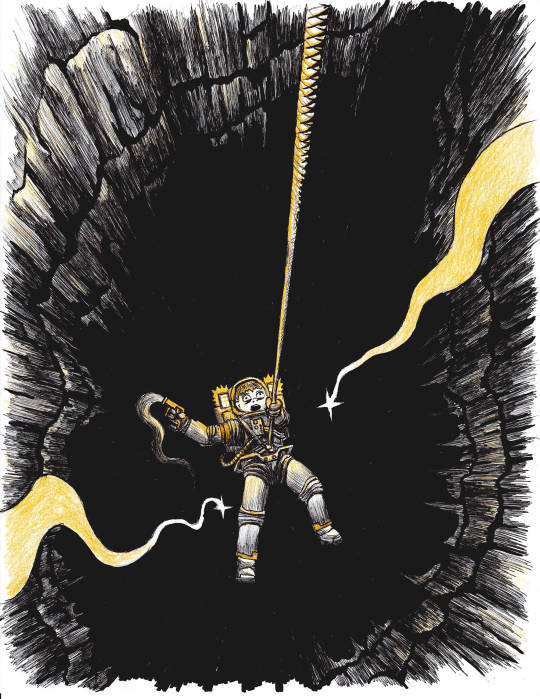
Once upon a time, far from here, at the bottom of the deepest shaft of the deepest mine, two boys stood regarding a pit that led yet deeper.
“You sure about this?”
“Yeah! C’mon, it’s not like there’s anything dangerous down there!”
Louis nervously leaned out over the fissure as far as he dared. It was true, there didn’t rightly seem to be anything at all down there; just blackness. The walls of the fissure passed beyond the range of their headlamps after the first twenty meters, and after that, floors and walls became nothing but indistinct void. It must be fifty meters deep, at least.
“You just let me down,” Peter pointed to the towing winch built into the belt of Louis’s suit. “Until I touch the bottom. And then when you see me standing down there walking around, you’ll be brave enough to come down too.”
“…What if there is no bottom?”
"...What do you mean 'if there's no bottom'? What else would there be?"
"I...? Uh... You know? I dunno."
"Every hole on every single one of the hundred million brazillion planets and moons in the universe has a bottom. Because if it didn’t, it would go straight through the place, and there’d be magma everywhere right? Which would make it not dark. But it is dark. Which means it doesn’t go forever.”
“That’s not what I mean.” Louis’s helmet was rattling around on his head as he shifted his weight this way and that, trying to find a comfortable position where he wasn’t sweaty. Even through a thick pressure suit, the body language was apparent. “I mean, like… Like… Okay, never mind.”
“C’mon dude. This is basic simple science stuff. And since basic simple science proves that there is a bottom, we can therefore find that bottom!”
“Yeah…”
“We know space pirates once used this moon as a hideaway. Maybe they hid treasure down there!”
“That’s stupid.”
“It’s not, it’s true. And it makes sense for them to hide their treasure down in the deepest, darkest hole they could find. And what’s deeper and darker than here? Nothing, that’s what! Look, my GPS says we’re… What, a kilometer below the surface already? No mines go that deep! This must’ve been dug by the first colony! You know. Before they disappeared.”
“Yeah, well…” Louis glancing at the floor behind them. “...Well, I guess the footprints were pretty weird.”
With no wind and no water on this moon, dust and dirt and stone remain exactly as they are until something disturbs them, meaning that footprints last forever, with newer ones layering on top of old ones. In a long-abandoned mine like this, one would have expected the most recent, top layer of prints to have been left by the mining tractor; the one that dug the tunnel. In most of the other tunnels, that’s just how it was. After all, there was never any reason the miners themselves to bodily enter the tunnel.
Except here, the tread marks weren’t the last tracks.
Louis and Peter had followed a set of three tracks, tracks from adult human boots, all the way down here… Two sets had been leading up to this very hole… But only one set could be seen returning…
“It must be pirates.” Peter nodded, as he gazed down into the crevice. “It’s the only explanation… That or aliens.”
“Aliens don’t exist.”
“Yeah, and that just leaves pirates, which makes more sense anyway.” Peter explained. “See, the Captain must have needed help from his second-in command to carry the treasure chest, but when they threw it in the hole, the Captian shot his buddy and threw him in too! Because the Captain knew that all pirates are nothing but dirty thieving buccaneers, so to keep his greatest fortune safe, he made sure that nobody else knew…! I bet we’ll find an evaporated mummy with a busted faceplate down there… And riches… Riches worth killing over… Gold and crystals and ancient forms of currency that have all been forgotten for centuries…”
Louis’s body language said he was almost convinced. (Not convinced enough to believe it, but almost convinced enough to try exploring it.) “But…” He offered one last objection. “Maybe they were just explorers or something. You know, like us. Maybe his buddy just got hurt down there, so he just carried him out… I mean, it doesn’t necessarily mean one of them died down there…”
“But there’s no piton left behind.” Peter gestured to the tunnel floor around them. “And no place where one was driven in… And they weren’t using jetpacks either, because there’s no disturbance in the dust from the downdraft… Which means they had no way back out.”
That tipped Louis over the edge, and he reluctantly began to unpack his climbing gear. “Oh-kaaaay…” He sighed, as he aimed the power-driver at the tunnel floor. There was a burst of compressed air from the driver, and a piton appeared in front of the barrel, embedded securely in the rock. He unspooled a length of cable from the winch and passed it through the piton’s pulley, then handed the end to Peter. “But… Uh… If you find anything scary down there, could you bring it back up so I can see it please?”
“You’re a baby.” Peter locked the cable into his harness, and stepped up to the edge of the crevice. “How are you a boy scout if you’re such a baby?”
“I’m a boy scout because I know everything.” Louis frowned, as he braced his feet against the side of the tunnel to balance out the winch. “I know how to maintenance all the types of engines that we use. I know how to build an airtight shelter out of nothing but rocks and resin. I know how to recycle urine without ever taking off my suit. I can signal for help in 23 languages. If we were crashlanded, then I would be the hero, and you would be the bumbling sidekick.”
“You also know how to be a baby.”
“I also know there was never any pirates on this moon.” Louis added. “Those are just rumors that sprung up around the old military depot in the Eastern hemisphere.”
“Which was destroyed by pirates!” Peter reminded him as he leaned into the cable. He bounced slightly, just to convince his mind that the thin material could actually hold his weight.
“Destroyed by themselves via routine self-destruction. That was standard scorched-earth policy back during the war.”
Louis leaned out over the blackness, at an angle where the cable was supporting the majority of his weight. And he prepared to step out into darkness. “Being a baby must be standard policy too, huh?”
"In certain circumstances yes, maybe being a baby is standard policy.”
“Your mom is standard policy.”
“Negative.”
“Line down.”
Naturally, Louis’s winch made no sound in the airless environment. All Peter could hear were his own boots scuffling and sliding down the first section of the crevice sides, and the faint rhythm of the winch vibrating down through the taught cable. And, of course, there were all the familiar background sounds: the hissing of the life support in his pack, the whirring of the water pump warming his extremities. And above all, his helmet echoed his own breathing back toward him, muffled and close and incredibly loud. That omnipresent, overbearing sound of breathing used to scare him when he’d first worn a space suit; made him feel either profoundly claustrophobic and alone, or feel like Darth Vader was standing behind him.
But now he was a boy scout. And boy scouts are many things. They aren’t babies, first of all. Second of all, they’re responsible, and dutiful, and they know their equipment. Third, they can survive outdoors. So in this day and age, when most doors opened into hard vacuum, you can know for darn sure that a good boy scout isn’t afraid to be out on his own in it, locking his life behind nothing but a little fabric and glass.
This fabric and glass was rugged, and tough, and meticulously well-maintained. It was his armor. And inside it, he was as safe. Safe as he was in his own home.
Peter found that the crevice was widening as he descended. The tunnel wall dropped sideways from beneath his feet, and he soon found himself hovering on his back, suspended from his harness like a sack of freight as the walls continued to recede above him. “Louis be advised.” Peter said. “Tunnel is widening significantly. I have lost physical contact with the wall. Over.”
“How is visual contact? Over.” Louis’s voice came through Peter’s radio, as it always had.
Peter looked left, and right. The ‘hole’ they’d descended seemed to actually be some sort of chasm or fissure, running through the moon’s crust like a cut or a tectonic crack. It stretched off into blackness to either end, far further than his beam could search, must be more than a hundred meters. As for the walls to either side of him, they were widening, dropping off into the distance steadily, like the incredibly steep, jagged walls of an upside-down canyon. He could still see them, but his light could only reach so far; if they became dim enough, he wouldn’t be able to focus on them past the slight glare reflecting off the scratches in his helmet.
And no, he could not yet see the bottom.
“Mediocre, and getting worse. Over.” Peter answered.
“Do you wish to abort? Over.” Louis asked.
“No!” Peter let himself hang flat on his back again, so he was looking straight up the cable at the opening above him. The glow from Louis’s light was brightly illuminating the inside of the mineshaft, forming a jagged splotch of bright brown surrounding the cable’s end. “No…” He repeated, talking to the light. “Just a bigger hole than I thought, that’s all. Don’t blame the Captain for throwing his treasure down here; it’s a good hiding spot. Over.”
Louis ignored that.
The winch continued to spin, the cable continued to unwind, the light continued to shrink above, the walls continued to recede.
“Peter be advised…” Louis’s voice was slow and careful, not quite nervous. “Tension in cable seems slightly uneven. Over.”
“Uneven?” Peter frowned up at his friend. “Louis, please elaborate. Over.”
“It’s decreasing… Like you’re getting lighter… Are you dropping rocks out of your pockets or anything? Over.”
“No… Is your winch speeding up?”
“No…”
There was a brief moment of silence while they both pondered all this.
“Maybe your legs are going numb.” Peter suggested. “Uh, over.”
“Maybe… Yeah, I dunno, I don’t think so… Seriously, if you’re messing with me-”
“I’m not messing with you…” That gave Peter an idea: mess with him. He began to flail his arms and legs to make the line bounce. “I… I think I feel it too!”
“You feel the tension decreasing?”
“No, it’s just kind of… Bumpy… Like somebody’s shaking it…! Are you moving around up there?”
“N-no, I’m not moving an inch!” Louis said. “Uh… Oh, wow, actually yeah, I can feel it bouncing too now!”
“I think something’s on the cable!” Peter cried out. “I think something grabbed it! Oh no, I can see it! OH MY GEEZ! It’s coming toward me!”
“WHATISWHATIS WHAT’S COMING TOWARD YOU?!?” Louis was getting hysterical.
The bumping in the line stopped. All was silent on the radio. Peter held his breath in gleeful anticipation.
“Oh.” Louis said after a few seconds. “Ha ha. Very funny. Over.”
“PFFWA HA HA!” Peter burst out in a spasm of laughter. “You should have heard you! Over.”
“Yeah, yeah, okay, you’ve had your laugh, now no more thrashing around, alright? Like seriously, you’ll freak me out… And if you were just planning on making a fool of me, you shouldn’t have invited me on the mission… Over.”
“It’s not a ‘mission’, and I didn’t ‘invite’ you. I said I was gonna go look for pirate treasure, and then you begged to come along. Over.”
“I didn’t beg.”
“Did too.”
“You’re stupid. Over.”
“You’re a baby. Now keep lining down; I never said stop. Over.”
Louis sighed and flipped the switch again.
The winch started spinning again.
Peter continued to drop.
Five minutes later, Louis finally spoke. “Peter come in; please tell me you’re getting near the bottom…! Over!”
Peter looked over his shoulder. “No, still can’t see a thing down there, over.”
Five minutes further, Louis’s voice had a sharpness to it. “WHEN should we abort, over?”
“Would you quit it with the abort talk?” Peter snapped, and shook his fist up at the fading light. “Just keep spooling down until I tell you to stop, okay? You’ve got, like, a barjillion meters of line in your winch, and it’s rated for, what, two tons?”
“Four.”
“Four! Four tons! That’s about 100 of me! In Earth gravity! This is, like, less than half Earth gravity, so that thing should be able to hold 200 of me, easy! I’m literally in no danger at all! Over.”
“But…!���
“Just keep spooling down until I tell you to stop. Okay? Over.”
“…Okay. Over.”
“Great. Over.”
“Yeah… Yeah, great. I will. Over.”
“Over.”
“Over yourself.”
“Over times two.”
“Over infinity. Over.”
The walls were getting wider and wider still, and Peter’s light was getting no brighter. Soon, the passing rock began to fade. Nothing mysterious about it, the walls just receded further and further until they merged with the black background, leaving nothing but blurs and shadows. And as Peter waited, it seemed that even those blurs were inching their way upward, to disappear into the ever-growing darkness he’d already passed.
Only the speck of light from the distant mineshaft remained clearly visible directly above; that and whatever length of cable was near enough to be seen. A pinpoint of light piercing down at him, and the cable pointing toward it like a finger, as if to remind him that he was not some lonely spider suspended on a web, but that there was light, and company, and good solid ground awaiting him above, whenever he should choose to return.
The last glimpses of rocks passed out of sight. There may as well be no more walls. He looked over his shoulder again, hoping, if not expecting, the floor to be coming up to meet him soon. Surely the bottom must be approaching soon, right…? But it was not.
His light had become utterly useless now, with nothing else around to illuminate. And when that realization struck him, it sowed the seed of doubt. Maybe Louis’s right. Maybe I shouldn’t do this. I should abort, let him reel me back topside, come back later with the scout leader and a big crane and some huge ol’ searchlights… Yeah… Yeah, this hole, this CHASM, was bigger than I ever would have imagined, and one kid with a headlamp isn’t enough to conquer it…
No…
No, keep going, Peter.
It’s got to end sometime.
He looked up at Louis’s dot of light above him. It’s got to end sometime. It’s not bottomless.
Unease built.
It festered in the back of his mind, surged forward every once in a while to try to bring him to panic, to get him to give up, but each time he forced it back. More and more he found himself staring upwards at the spot of light. Strangely enough, it seemed to be getting reddish. As if blood were throbbing forward into his eyesockets, or as if he was gradually being engulfed in some fog, or filter. Perhaps this pit was flooded with trace amounts of some heavy, reddish gas, and as he descended the depths of it clouded over.
However it was happening, he had become utterly fixated on that spot of light, measuring how it faded and shrunk and reddened, trying to estimate when that final singular anchor would fade away.
Five more minutes passed.
You know, it was bizarre. He hadn’t noticed it quite as fast as Louis had, since he’d been hanging comfortably by his harness instead of bracing against the walls with the winch, but Louis was right: the tension in the line was decreasing.
How was it decreasing? How did that make any sense? No, he wasn’t dropping rocks from his pockets, no, the winch couldn’t be gradually accelerating, as the motor only went one speed… It didn’t make any sense.
Ten minutes.
The light… Was the light getting fainter up above? It seems that now, Peter could barely make out the pinprick of red light that was the opening of the mineshaft. There was only the cable, and himself, hanging in the black.
Nineteen minutes.
Nineteen and a half minutes.
Peter found himself staring at the timer in his helmet, waiting for the seconds to finally add up to the big two-oh, and he’d finally have a good round number to affix to his boredom, and his boredom was the excuse he would affix to his request that they finally abort this pointless plunge.
“H-hey!” He radioed up to Louis. “Y-you know dude, th-th-this is a drag. It’s been twenty minutes. Let’s just reverse it now, eh? This is getting silly! Bring me back up! Over.” It felt really good to finally say it actually; to admit that his friend was right; to give up. It felt good, in a way, to never have to discover what lay at the bottom of this hole.
But horror beyond all horrors, there was no answer!
“Louis? LOUIS! Louis, come in! Louis, do you read?!? Over!”
He was still going down!
“LOUIS COME IN!”
His friend didn’t respond, but the line kept descending, and the tension kept lowering, and the light was very, very red and kept fading, and Peter found himself in tears, crying and trembling.
He looked back over his shoulder again, but he still couldn’t see the bottom!
What’s going on?!? Why can’t Louis hear me?!? How far down does it go?!?
In a sudden flash of inspiration, he remembered; he remembered what he should have done in the first place, before ever starting into the pit. How could I forget? In all the movies, whenever anybody descends into the dark, they always throw a flare or a flashlight or a torch first! They always drop a light so they can get a gauge of how far it goes! It’s only smart! Heck, forget movies, I’m a boy scout! I should have instantly known to do that, how could I forget?!?
I still can!
With shaking hands he fumbled the emergency flare gun out of his belt, and loaded a brightly-colored canister into the barrel. Then he twisted around in the harness, pointed the gun straight downwards into the exact center of that gaping black void, and pulled the trigger.
The flare burst from the gun, and flew straight down. Gravity continuously accelerated it, and without air resistance, it kept going faster and faster, a brilliant yellow missile glowing with incredible brightness, speeding ever faster.
And continued.
And continued.
And continued.
It slowly faded from yellow to white to blue, growing steadily more distant and small and faint with the distance. Finally, after craning his neck to watch it for what felt like minutes, he found he could no longer even see it.
Good grief! Up on the surface, those flares are normally visible from kilometers out! Kilometers!
Louis was right all along! It’s bottomless! IT’S A BOTTOMLESS PIT!!
He looked back upwards. His panic, which was already skyrocketing, was suddenly compounded when he realized that he couldn’t see the light of the mineshaft anymore. He hurriedly turned off the light in his own helmet, in hopes that he could see better without the slight glare. Yes, that was it; if he killed all his own lights, he could just barely make out the mineshaft, shining like a red star high above. “Louis!” He screamed into his radio. “Louis, bring me up! It’s bottomless! You were right, it goes on forever! You gotta bring me up! Abort! LINE UP!!”
No answer.
He fumbled a second flare out of his pocket, and reloaded. Taking careful aim, the very most meticulous and steady aim, he pointed the missile directly at the patch of light. Perhaps if he could be a totally bona-fide sniper with this little flare pistol, perhaps if the flare traveled dead-center, then perhaps it would get near enough to the shaft for Louis to glimpse its glow, and realize that their radios had been somehow compromised, and reverse the line.
He fired.
The second yellow missile streaked from the gun, this time in exactly the opposite direction of the first.
It went straight up, growing redder and redder as it did.
A minute later, it returned to its yellow color as it came straight back down. It passed by Peter again not 10 meters to his left.
And it disappeared into the dark below with the other flare, once again fading to white and then blue. Now that Peter had his lights off, he thought he could still see the first flare glowing in the incredible distance. It hadn’t hit the floor yet.
Bottomless, bottomless…
He squeezed his eyes shut, not wanting to look at anything anymore. Wanting to exchange the hungry, malicious blackness around him for the close, comfy blackness of the backside of his eyelids. Anything to pretend he wasn’t where he was. But the silence was heavy on his ears. Louis wasn’t there any more, only the hissing of his suit’s life support, the whirring of its heater, and his own breathing. And of course he couldn’t ignore the tension in his harness; The tension is still dropping! Now it’s about half what it should be; like for some physically impossible reason the cable is just stretching and I’m falling faster and faster forever and ever and I can’t feel it! Except I can feel it! I feel like I weigh half of what I ought, like I’m halfway to the moon’s center. But that’s impossible! How could he lower me so deep? And if I’m so deep, where’s the magma?!? Oh God, how can it not have a bottom?!?
God…
That’s right, God!
Without any hesitation, Peter curled into a ball, folded the gloves of his spacesuit against his helmet, and began to pray.
“Dear God…! Dear God, come in God! God come in, I’m scared! Please help! Please help it not be bottomless!” He wondered if there was some kind of enormous monster instead of a bottom, or if the moon was hollow and infested with Aliens, or if this pit led straight to hell. “Please make Louis reverse the line!” He pleaded. “Please make it be alright again…! And…! Andandand if you don’t do any of those other things God, then please, please, please make me brave…!”
He continued down.
“Please make me brave.”
He never stopped.
“A-a-amen… Over.” He stuttered. And as his prayer finished, he knew that even through a kilometer of stone, even across the vast reaches of space, even from out of the depths of this unbelievable void, God had heard him. That’s right… God is in control… God knows where this pit leads, heck, he probably created this pit! That means he knows when I’ll reach the bottom. He knows if I’m gonna get back out or if I’m gonna die… In fact, he knew all this before I ever got up this morning. He knows what I’ll find down here, and he still loves me… God loves me. He’s still looking out for me.
Even down here.
And God answered Peter’s prayer; God made him brave.
Peter opened his eyes.
And then he turned his lights back on, and found that the empty pit wasn’t quite so empty anymore. Way off in the distance to his left and right, his lights seemed to be illuminating something… Not a bottom, but something along the walls; yes, the walls seemed to be narrowing again, at least partially… That was a good sign.
The walls got nearer.
And now that they were back in range of his light, he could see something really quite strange: they were no longer made of rock. He could scarcely believe his eyes at first, but the walls were made of metal now, shinier and more uniform. On his left side, he was currently moving past some kind of enormous, curved surface, like the flank of an incredible water tank. A line of rivets bordering a seam confirmed its artificial nature.
On his other side, there was what appeared to be some kind of weight-bearing truss, like you’d see holding up the archways of an old bridge. There was another tank beside the truss too, and what looked like a ganglion of pipes, just on the edge of the range of his light.
As he continued downward, there were other structures. There were round, rivetted tanks similar to the first one, most of them smaller and miscellaneous, but a few quite a bit larger. In between the tanks and the trusses, great cuboid somethings were bolted to trusses, and the housings and shafts of unfamiliar machinery poked out and interconnected here and there. All through the labyrinthian industrial complex, pipes of every imaginable shape and size stretched and curled.
He sure was glad that God had made him brave. With that bravery, he hazarded another communication. “Louis, be advised.” He said, just in case his friend was still able to hear him. “The tunnel walls now appear populated with mechanical structures. Looks like it could be a factory or a refining installation of some kind. Maybe something else. Not seeing any movement or people, so I think it’s abandoned. And there are no lights, so I’m assuming it’s powerless. I’m also not seeing any words or language on any of the pipes, so your guess is good as mine as to who made it… Yeah. Anyway, it’s weird. Over.”
Louis evidently didn’t hear him.
“Louis, be advised.” He continued a few minutes later. “Looks like the machinery is ending. The last of it is passing out of sight, and I’m in blackness again. It was all just on the walls, and the pit itself is still bottomless… Over.”
The tension in the line was as low as it ever had been, perhaps a quarter of his own weight. He thought back for a moment to his science classes: Newton said that if he wasn’t changing speed at all, then that means the total amount of force on him balanced out to zero. Meaning the tension in the line must be equal to his weight, which meant that he must be getting lighter. But he wasn’t losing any mass, so that means the gravity must be decreasing. Somehow.
He imagined that if it continued, he would eventually be weightless entirely. It didn’t make any sense to him how that was happening, but he understood how the affect was progressing, and it was consistent and logical in its own queer way.
It was logical. It didn’t necessarily make sense, but it made a sense.
The logic and predictability of it made him feel a little better, and he allowed himself to relax. In fact, as he rested on the end of the tether under ever-decreasing stress, the inside of his suit began to seem very comfy. Indeed, he even began to feel sleepy…
Well… I can’t keep going down forever. Louis doesn’t have infinite cable in his winch, and his winch doesn’t have infinite batteries. He’s smart enough to know when enough is enough, and he’ll bring me back up eventually.
…
Thank you, God, for making me brave.
He turned off his light to save battery power in the suit, and settled back to wait.
23 notes
·
View notes
Photo
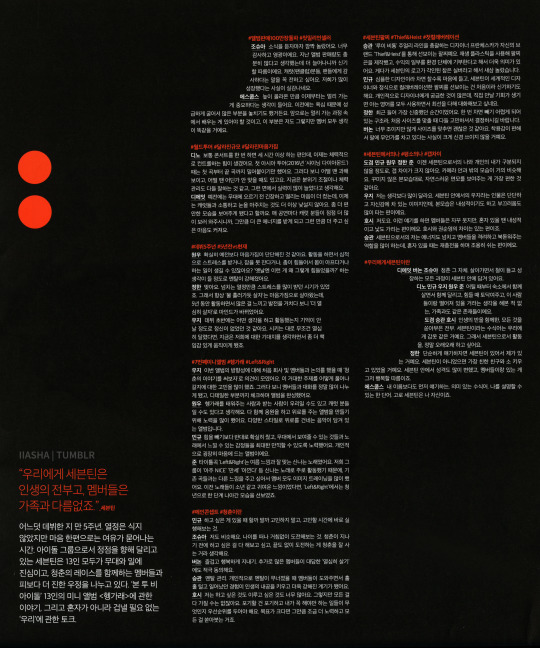
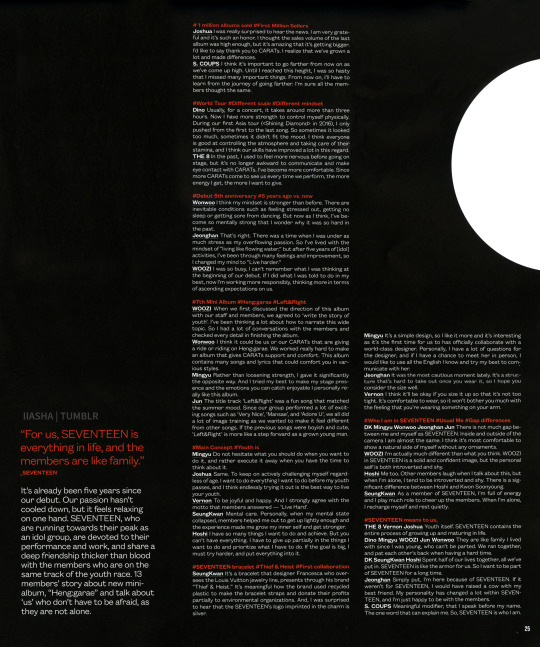
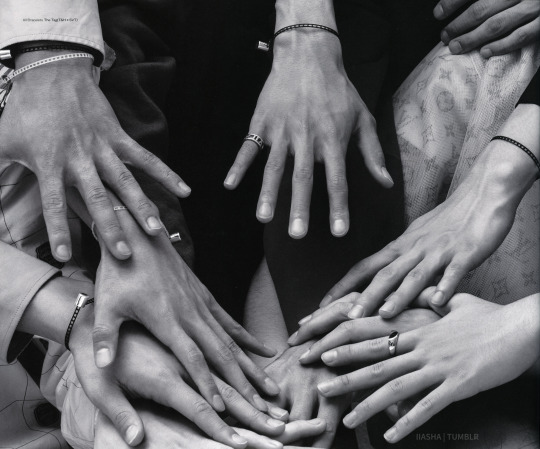
[scans] monotube magazine vol. 2 | group interview interview under cut
“For us, SEVENTEEN is everything in life, and the members are like family.” - SEVENTEEN
It’s already been five years since our debut. Our passion hasn’t cooled down, but it feels relaxing on one hand. SEVENTEEN, who are running towards their peak as an idol group, are devoted to their performance and work, and share a deep friendship thicker than blood with the members who are on the same track of the youth race. 13 members’ story about new mini-album, “Heng:garae” and talk about “us” who don’t have to be afraid, as they are not alone.
#1 million albums sold #First Million Sellers
Joshua: I was really surprised to hear the news. I am very grateful and it’s such an honor. I thought the sales volume of the last album was high enough, but it’s amazing that it’s getting bigger. I’d like to say thank you to CARATs. I realize that we’ve grown a lot and made differences. S.Coups: I think it’s important to go farther from now on as we’ve come up so high. Until I reached this height, I was so hasty that I missed many important things. From now on, I’ll have to learn from the journey of going farther. I’m sure all the members thought the same.
#World Tour #Different scale #Different mindset
Dino: Usually for a concert, it takes around more than three hours. Now I have more strength to control myself physically. During our first Asia tour ( in 2016), I only pushed from the first to the last song. So sometimes it looked too much, sometimes it didn’t fit the mood. I think everyone is good at controlling the atmosphere and taking care of their stamina, and I think our skills have improved a lot in this regard. The8: In the past, I used to feel more nervous before going on stage, but it’s no longer awkward to communicate and make eye contact with CARATs. I’ve become more comfortable. Since more CARATs come to see us every time we perform, the more energy I get, the more I want to give.
#Debut 5th anniversary #5 years ago vs. now
Wonwoo: I think my mindset is stronger than before. There are inevitable conditions such as feeling stressed out, getting no sleep, or getting sore from dancing. But now as I think, I’ve become so mentally strong that I wonder why it was so hard in the past. Jeonghan: That’s right. There was a time when I was under as much stress as my overflowing passion. So I’ve lived with the mindset of “living like flowing water,” but after five years of [idol] activities, I’ve been through many feelings and improvement, so I changed my mind to “Live harder.” Woozi: I was so busy, I can’t remember what I was thinking at the beginning of our debut. If I did what I was told to do in my best, now I’m working more responsibly, thinking more in terms of ascending expectations on us.
#7th Mini Album #Heng:garae #Left&Right
Woozi: When we first discussed the direction of this album with our staff and members, we agreed to “write the story of youth.” I’ve been thinking a lot about how to narrate this wide topic. So I had a lot of conversations with the members and checked every detail in finishing the album. Wonwoo: I think it could be us or our CARATs that are giving a ride or riding on Heng:garae. We worked really hard to make an album that gives CARATs support and comfort. This album contains many songs and lyrics that could comfort you in various styles. Mingyu: Rather than loosening strength, I gave it significantly the opposite way. And I tried my best to make my stage presence and the emotions you can catch enjoyable. I personally really like this album. Jun: The title track “Left&Right” was a fun song that matched the summer mood. Since our group performed a lot of exciting songs such as “Very Nice”, “Mansae”, and “Adore U”, we all did a lot of image training as we wanted to make it feel different from other songs. If the previous songs were boyish and cute, “Left&Right” is more like a step forward as a grown young man.
#Main Concept #Youth is
Mingyu: Do not hesitate what you should do when you want to do it, and rather execute it away when you have the time to think about it. Joshua: Same. To keep on actively challenging myself regardless of age. I want to do everything I want to do before my youth passes, and I think endlessly trying it out is the best way to live your youth. Vernon: To be joyful and happy. And I strongly agree with the motto that members answered - “Live Hard”. Seungkwan: Mental care. Personally, when my mental state collapsed, members helped me out to get up lightly enough and the experience made me grow my inner self and get stronger. Hoshi: I have so many things I want to do and achieve. But you can’t have everything. I have to give up partially in the things I want to do and prioritize what I have to do. If the goal is big, I must try harder, and put everything into it.
#SEVENTEEN bracelet #Theif & Heist #First collaboration
Seungkwan: It’s a bracelet that designer Francesca who oversees the Louis Vuitton jewelry line, presents through his brand “Thief & Heist.” It’s meaningful how the brand used recycled plastic to make the bracelet straps and donate their profits partially to environmental organizations. And, I was surprised to hear that the SEVENTEEN logo imprinted in the charm is silver. Mingyu: It’s a simple design, so I like it more and it’s interesting as it’s the first time for us to officially collaborate with a world-class designer. Personally, I have a lot of questions for the designer, and if I have a chance to meet her in person, I would like to use all the English I know and try my best to communicate with her. Jeonghan: It was the most cautious moment lately. It’s a structure that’s hard to take out once you wear it, so I hope you consider the size well. Vernon: I think it’s be okay if you size it up so that it’s not too tight. It’s comfortable to wear, so it won’t bother you much with the feeling that you’re wearing something on your arm.
#Who I am in SEVENTEEN #Usual Me #Gap differences
DK, Mingyu, Wonwoo, Jeonghan, Jun: There is not much gap between me and myself as SEVENTEEN. Inside and outside of the camera I am almost the same. I think it’s most comfortable to show a natural side of myself without any ornaments. Woozi: I’m actually much different than what you think. Woozi in SEVENTEEN is a solid and confident image, but the personal self is both introverted and shy. Hoshi: Me too. Other members laugh when I talk about this, but when I’m alone, I tend to be introverted and shy. There is a significant difference between Hoshi and Kwon Soonyoung. Seungkwan: As a member of SEVENTEEN, I’m full of energy and I play much role to cheer up the members. When I’m alone, I recharge myself and rest quietly.
#SEVENTEEN means to us,
The8, Vernon, Joshua: Youth itself. SEVENTEEN contains the entire process of growing up and maturing in life. Dino, Mingyu, Woozi, Jun, Wonwoo: They are like family I lived with since I was young, who can’t be parted. We ran together, and pat each other’s back when having a hard time. DK, Seungkwan, Hoshi: Spent half of our lives together, all we’ve put in. SEVENTEEN is like the armor for us. So I want to be part of SEVENTEEN for a long time. Jeonghan: Simply put, I’m here because of SEVENTEEN. If it weren’t for SEVENTEEN, I would have raised a cow with my best friend. My personality has changed a lot within SEVENTEEN, and I’m just happy to be with the members. S.Coups: Meaningful modifier, that I speak before my name. The one word that can explain me. So, SEVENTEEN is who I am.
#seventeen#svt#seventeen scans#t:scans#g:seventeen#u:ot13#t:text#a:monotube#m:misc#so i am scribing the interviews#bc i feel like w tumblr's resizing the text will probably be small (?)#or just not load lmao either way it's convenient to have in a text format ig#was going through them and decided to edit this set as well since it's relatively straightforward lmao#the page that had all the creases i can just boost to all black#there's also another full spread but it's literally just a giant black SEVENTEEN on a red background so#prob not gonna bother with that unless someone REALLY wants to see it i promise you it isn't very interesting ajfkdla#also JEONGHAN COW FARMER#translations
89 notes
·
View notes
Link
Celebrities gracing the 'green' carpet show Oscar-worthy sustainable dresses can still be glamorous Written by Marianna Cerini, CNN This story was produced as part of CNN Style’s The September Issues, a hub for facts, features and opinions about fashion, the climate crisis, and you. Only just over a decade ago, sustainability in fashion was a fringe issue. But today, it has become a major talking point — even at important red carpet events, as evidenced by this year’s Oscars. There, Joaquin Phoenix wore the same Stella McCartney tuxedo he had sported at the Golden Globes, Baftas and a number of other award shows this season in a bid to reduce waste. Saoirse Ronan appeared in a Gucci gown with a bodice made using the surplus fabric from her Baftas look. Costume designer Arianne Phillips was in an upcycled version of the Moschino dress she first wore at the 2012 Academy Awards. And that’s just to name a few. Red carpet awareness has been slowly bubbling over the past decade, thanks in part to future-forward initiatives asking celebrities to wear more environmentally-friendly designs at major events. In 2009, climate activist and former actress Suzy Amis Cameron launched the Red Carpet Green Dress (RCGD) campaign, which runs a contest for young and established designers to create garments according to strict sustainability criteria. One year later, Livia Firth, founder of consultancy Eco-Age, followed with her now global Green Carpet Challenge, which not only encourages celebrities to dress sustainably at events, but also works with fashion houses on innovative materials and techniques. Saoirse Ronan attended the 92nd Oscars in a gown made, partly, with leftover fabric from her Baftas dress earlier that month. Credit: Amy Sussman/Getty Images Livia Firth’s custom tangerine caftan by Richard Quinn for the 2019 Met Gala featured recycled plastic bottles and Swarovski upcycled crystals. Credit: Dia Dipasupil/FilmMagic/Getty Images In recent years, celebrities, in collaboration with RCGD or Eco-Age, have turned up in gowns made of recycled materials or dead stock, showing they can make statements about sustainability and look good while doing it. Some of these looks — as exemplified by Meryl Streep in Lanvin, Viola Davis in Valentino and Emma Watson in Calvin Klein — showed the possibilities of recycled beverage containers. Watson’s trouser-gown hybrid, which she wore to the 2016 Met Gala, was constructed using a yarn made entirely from used plastic bottles. Emma Watson dons dress made of used plastic bottles Viola Davis wore a Valentino gown for the Green Carpet Challenge to the 2012 Baftas. Its fabric was crafted from recycled materials. Credit: Richard Young/Shutterstock Getting stars to make greener choices wasn’t a straightforward process, according to Samata Pattinson, the CEO of Red Carpet Green Dress. Initially, “it was really difficult to get talent on board with our campaign, because they had a limited view of what it would look like,” she said in an email interview. “They were anxious, they didn’t know if it would look good. The assumption was that it would be hemp, something ‘granola.'” But as awareness of fashion’s devastating impact on the climate grows, so too does interest from celebrities. “The red carpet is one of the biggest storytelling platforms there is, and an opportunity to change conversations,” said Harriet Vocking, the chief brand officer of Eco-Age, discussing the Green Carpet Challenge in a phone interview. “Wearing a sustainable garment (at award ceremonies) has become a way to lead by example, but also challenge the current fashion system.” Costume designer Arianne Phillips upcycled the Moschino dress she first wore at the 2012 Oscars (above) into a new gown for the 2020 ceremony (below). Credit: Ethan Miller/Getty Images The new version was created in collaboration with Moschino’s Jeremy Scott. Credit: Amy Sussman/Getty Images To date, Eco-Age has worked with more than 250 celebrities to shine a light on sustainability, although Vocking, like Pattinson, also spoke of having to persuade people at first, “as opposed to now, where we have incoming requests.” Vocking pinpointed Watson’s Calvin Klein dress as a pivotal moment for the sustainable red carpet movement. “Watson propelled the dialogue to new heights, because her gown was so well-received by everyone, and showed that the quality is there to make stunning and sustainable dresses,” she explained. “It moved the needle on how we see sustainable fashion.” Model Adut Akech attends the Green Carpet Fashion Awards in 2019. Her turquoise Valentino “eco-couture” gown was made of reclaimed materials and organic silk. Credit: Stefania D’Alessandro/Getty Images Joaquin Phoenix wore the same Stella McCartney tuxedo to successive awards ceremonies. Credit: Frazer Harrison/Getty Images The bigger picture Of course, there’s only so much a red carpet dress can do in terms of tangible change. What’s more, award shows themselves have a huge carbon footprint, with large amounts of energy required to stage them, and the waste left to be disposed of in their aftermath. Not to mention the air travel required of stars and their entourages. The process of dressing celebrities for the red carpet is undeniably wasteful too, with custom-made gowns and jewelry flown over, only to be worn once, feeding into fast-fashion’s obsession with newness. Thandie Newton wore a Vivienne Westwood dress to the 2018 Cannes Film Festival premiere of “Solo: A Star Wars Story.” The dress, created in collaboration with Eco-Age, featured hand-painted renderings of the Black characters in the franchise, and was made of organic ‘peau de soie’ silk and upcycled crystals. Credit: Pascal Le Segretain/Getty Images Léa Seydoux’s Louis Vuitton dress, worn to the 2020 Oscars, was created in partnership with the Red Carpet Green Dress initiative. The gown incorporated a textile made from Tencel luxe filament yarn, and organic silk faille paired with organic satin sandals. Credit: Amy Sussman/Getty Images Neither green carpet initiative has shied away from these inconvenient truths. Rather, they’ve approached sustainability from different angles. “In the beginning, we were really looking at certified materials and sustainable design solutions with dyes for example, but (our ethos) has grown to include wider conversations (from) refurbishing and repurposing, plant-based or vegan materials, and using recycled plastic, to circular design systems,” Pattinson said. “It’s also grown to more visibly include a social justice element — how we are treating people within this industry and how we treat the people who make our clothes.” Embracing vintage — a trend harnessed by Penelope Cruz, Margot Robbie and Kim Kardashian West on this year’s red carpets — has become another way of cutting down on carbon emissions. Pattinson pointed to Emma Roberts’ vintage Armani Prive dress for the 2017 Academy Awards as an example. “Roberts’ gown was important because it showed that, as much as we must look at new ways of making things sustainable, we still have to have a conversation about how there is so much beauty in what’s already been made,” she said. Timothée Chalamet’s Prada outfit at the 2020 Oscars was made using yarn made from regenerated nylon, created from materials such as ocean plastics, fishing nets and textile fiber waste. A vintage Cartier brooch finished the look. Credit: Amy Sussman/Getty Images Similarly, Eco-Age began its #30wears campaign, which invites shoppers to ask themselves whether they’ll wear a piece of clothing at least 30 times, encouraging them to consider a garment’s lifecycle and promoting a slower approach to fashion. The consultancy has also challenged its own red carpet event — the annual Green Fashion Awards, which honors fashion players committed to change in the sector’s production chain — to find other ways to reduce waste. These have included the use of recycled fishing nets for its red carpet, potted flowers that can be later donated or reused, and recycled film sets for its backdrops. “Raising awareness works,” Vocking said. “But for positive impact to be real, every single step of the chain has to be taken into consideration.” Update: A quote in this story was amended after publication for clarity. Source link Orbem News #Carpet #Celebrities #dresses #glamorous #gracing #green #Oscarworthy #Show #sustainable
0 notes
Text
PROGRAM NOTES: WGTE'S JAZZ SPECTRUM, 5 DECEMBER 2020
Back in early November, my old friend asked if I wanted to put together a show. He'd had some election time voting rights legal work and probably needed a breather. I offered this playlist as a draft show for 14 November, but he fell ill on 11 November and this simply remained in the queue.
I'm really really glad he's better and pleased that this show got aired.
I had contributed some of the Charlie Parker Centenary segments and experimented with grand themes shows (in September in celebration of Artemis's album release or a celebration of St Louis's jazz heritage). This show recycles elements of those drafts, but I loosen things up to make a series of smaller statements and follow threads, some of which are there to amuse me. Above all, I tried to include some of the compositions that have caught my ear. There is also plenty of Ellington/Strayhorn and Monk as there should be every week.
These notes then are to explain the little puzzles and to remind myself of the inside jokes.
SET 1
Anat Cohen Tentet, Happy Song, “Happy Song”
Artemis, Artemis, “Goddess of the Hunt”
Ingrid Jensen/Steve Treseler, Invisible Sounds, “Everybody’s Song But My Own”
Happy Song just makes me happy just as Anat Cohen does and not just with her catchy tune. She's part of the supergroup Artemis, making this set a condensed part of that theme. Artemis is the Goddess of the Hunt, so Allison Miller's tune is a show case for the band as a whole. Ingrid Jensen is the trumpeter in the band and her project honoring fellow Canadian trumpeter Kenny Wheeler becomes a chance to feature the iconic Everybody's Song But My Own.
Set 2
Melissa Aldana and Crash Trio, Melissa Aldana and Crash Trio, “Ask Me Now”
Fly, Sky and Country, “Dharma Days”
Lee Konitz, Motion, “All of Me”
This set explores the sax/bass/drums trio with players who fill the space not so much with big muscular tones or extreme flurries of notes, but just damn smart ideas. Melissa Aldana is also part of Artemis and she gets in the first Thelonious Monk tune. Mark Turner intrigues me and cites both Warne Marsh and John Coltrane--an interesting combination--as influences. Playing Lee Konitz and from his landmark album is always a good idea.
SET 3
Kenny Wheeler, Angel Song, “Kind Folk”
Kenny Werner, Kenny Werner at Maybeck, “In Your Own Sweet Way>Naima”
More Kenny Wheeler in his own voice and from an album with Konitz, Bill Frisell, and Dave Holland kicks off a Kenny run. Werner is one of the pianists I've discovered as streaming lets me be part of the NYC jazz scene. He's full of taste and ideas, including this brilliant Dave Brubeck/Coltrane medley.
Set 4
Kenny Barron/Dave Holland Trio, Without Deception, “Warm Valley”
Duke Ellington, The Smithsonian Collection of Classic Jazz, “East St. Louis Toodle-Oo”
Oliver Nelson, Blues and the Abstract Truth, “Yearnin’” or Tommy Flanagan Trio, Moodsville, “Come Sunday”
Duke Ellington, Such Sweet Thunder, “Up and Down, Up and Down”
Another Kenny with taste and ideas is Mr. Barron and he gets the first Ellington/Staryhorn tune.
This is part St. Louis set, part Ellington set. If “Yearnin’” (picked for its Dolphy solo) is too long, then it’s an Ellington set.
Set 5
Clark Terry, Serenade to a Bus Seat, “Serenade to a Bus Seat”
Miles Davis, Young Man with a Horn, “Dear Old Stockholm”
Lester Bowie, The Great Pretender, “Rios Negros”
This segment is lifted intact from the St. Louis show in honor of our town's trumpet heritage. More Clark Terry with one of his best known compositions before some early Miles when East St. Louis was maybe still a part of his sound as it was forming. Lester Bowie is also from here though he was well established with the Art Ensemble of Chicago by the time he recorded this album on ECM that was on my turntable often when we were discovering the music.
Set 6
Tony Bennet/Bill Charlap, The Silver Lining, “The Song is You”
George Mraz with Cyrus Chestnut and Rich Perry, "Christina"
George Cables George Cables Songbook, “AKA Reggie”
I have only four singers tonight with three of them for the upcoming Song of the Week (and two of those singers are Frank Sinatra). I treasure The Song is You and Bill Charlap and Tony Bennet, so win/win/win. Christina and AKA Reggie are treasured tunes that I found via stream in this odd season, a bit of lemonade from the bushels and bushels of lemons we have. Cyrus Chestnut and George Cables have been nicely present too across the venues.
Song of the Week—“Everything Happens to Me”
Set 7
Frank Sinatra, The Essential Frank Sinatra with the Tommy Dorsey Orchester
Thelonious Monk, Alone in San Francisco
Charlie Parker, Charlie Parker with Strings
Chet Baker, It Could Happen to You
Set 8
Bill Evans Trio, Time Remembered
Sonny Rollins, On Impulse
Frank Sinatra, Everything Happens to Me
The Song Is You might well have been in this slot, but I discovered Everything Happens to Me at the end of an archived Kenny Barron/Charlie Haden gig. So I hared down versions as many versions of the tune as I could. I've tried to see how the magic works as I play both tunes when I sit at the piano. Early Sinatra and then late Frank book end the sets. The last is just so emotionally powerful. Sure there are strings and full arrangement, but it is such a booze and cigarettes song that makes late Sinatra perfect. Chet Baker offers a different vulnerability plus a trumpet solo. Monk recorded his version while his beloved Nellie was in the hospital, so there's some pathos in his version too. You may have heard of the other three. Hardly random filler.
Set 9
Charlie Haden with Geri Allen and Paul Motian, The Montreal Tapes, “Dolphy’s Dance”
Kenny Barron/Charlie Haden, Night and the City, “Twilight”
If I owe my discovery to Barron/Haden, I wanted to include them. This then is a Charlie Haden set with his tribute to Dolphy who is one of the heros.
Set 10
Tommy Flanagan, Theolonica, “Pannonica”
Hank Jones, Bop Redux, “Ruby My Dear”
Sir Roland Hanna, Sir Roland Hanna and George Mraz Play for Monk, “In Walked Bud”
Barry Harris, For the Moment, “Monk Medley: Reflections>Light Blue>Well You Needn’t>Rhythm-ning”
Fritz had suggested listening to these four Detroit pianists. Besides being a good idea in its own right it opened up a Monk set. These are such solid thoughtful players and Monk is so foundational.
Set 11
Charles Mingus, Mingus in Europe, “Orange Was the Color of Her Dress Then Blue Silk”
Jack DeJohnette’s Special Edition, Tin Can Alley, “Pastel Rhapsody”
Pastel Rhapsody was one of the treasured tunes of my youth so it's how I wanted to send the show out with it. Jack DeJohnette's piano seemed an important element of his overall musicianship. Charles Mingus is a lion of the music, but his band with Dolphy was magic.
This was huge fun with all its little twists and amusements. It opens up distinct possibilities for putting together future shows and segments.
0 notes
Photo

many in US struggle to pay rent. Their stories.
The National Multifamily Housing Council found a 12 percentage point decrease in the share of apartment households that paid their rent through April 5.
Last weekend, Apartment List surveyed 4,129 people and asked whether they were able to pay their mortgage or rent on April 1. The result: 1 in 4 renters/homeowners did not pay it in full, and of the those people who were unable to make their payment, 45 percent of renters and 44 percent of homeowners reached an agreement with their landlords or lenders to defer or reduce their payments.
Most state and local governments are putting evictions on pause as states prepare to pay unemployment and the federal government prepares to send stimulus checks. So for most, April’s knock won’t come with a notice to get out.
A roof over the head is one of the most basic needs in life. Without money for rent, how can the other bills get paid? And while many will get a reprieve in April, eventually the rent comes due, whether or not the restaurant, plant, or construction site reopens when the COVID-19 threat lessens.
Here are some of the stories of Americans trying to make the rent, this month and beyond:
At 21 years old, Jade Brooks pulls in her family’s only full-time salary, working at a hospital switchboard.
Brooks’s mother just lost her job at a health insurance company — a casualty of the plummeting economy. She’s found part-time work at the hospital, but between them, they make only $400 weekly after taxes and insurance, Brooks said. Their rent is $1,810.
During sleepless nights, Brooks worries most about her 8-year-old cousin, who lives with them.
“I don’t want her to grow up in a homeless shelter, having to sleep in a bunk bed with other people, asking why we have to stand in a long line to get a room to sleep in, why we have to stand in a long line to get food, why she can’t invite her friends over,’’ Brooks said. “It’s hard to explain that to an 8-year-old.’’
— Michael Casey, Boston
Itza Sanchez knows she can’t make her $400 rent for April. She’s praying to the Virgin of Guadalupe that she doesn’t get kicked out of her Richmond, Va., mobile-home park.
Sanchez made her money searching for and recycling scrap metal and selling tamales in a heavily Hispanic neighborhood. Fear of getting sick has stopped both income streams.
A single mother of two who emigrated from Honduras to the United States 14 years ago, Sanchez’s 7-year-old daughter and 11-year-old son have been eating lunches delivered to the neighborhood by schools and depending on churches for other meals.
“I’m basically penniless,’’ Sanchez, 39, said in Spanish.
She hasn’t heard from the landlord about what will happen if the rent isn’t paid. So she keeps praying.
“May she help us. May the Virgin put her love over us and help us.’’
— Regina Garcia Cano, Washington
Andrea Larson made $70,000 a year curating wine lists and suggesting pairings to customers at 5th & Taylor. But the popular Nashville restaurant closed its dining area, and working as a sommelier isn’t something Larson can do from home.
The first unemployment check was $275 for a week. Larson said she was humiliated but applied for food stamps.
“I’m screwed financially,’’ Larson said. “If I do pay my rent, it’s going to eat into my food money.’’
Larson, 42, moved from a high-rise downtown apartment to a house in east Nashville four months ago. Rent was cheaper. She planned to pay off debt and start saving. Instead, she called credit card companies and said she couldn’t pay the minimum.
Larson’s restaurant offered a few shifts answering phones for takeout, but she figures it’s not worth the risk of getting COVID-19.
“I do wine, and nobody wants to hear about wine right now,’’ she said. ‘‘They just want to chug it.’’
— Travis Loller, Nashville
Roushaunda Williams was able to scrimp and use credit card cash advances to pay the $1,850 rent for April for her two-bedroom Uptown Chicago apartment.
But the rent comes due again in 30 days. Can she afford a smaller apartment in her building if one’s available? Should she move in with friends if they’ll let her?
“April 1 isn’t even here yet, and I’m already working on what I’m going to do for May 1,’’ Williams, 52, said.
Before being laid off, she made drinks and chatted with people from around the world for 20 years as a bartender at the Palmer House Hilton Hotel in the heart of Chicago’s downtown Loop.
Her income depended on tips — in the best times, she’d make $70,000 to $100,000 annually. Now, she’s on unemployment for the first time and searching for work.
— Kathleen Foody, Chicago
Tnia Morgan shares her Baltimore County, Md., town house with her 18-year-old pregnant daughter and 18-year-old nephew. And they all spend a lot more time together since Morgan was laid off March 6 from her job serving food at a hotel banquet hall.
Morgan’s landlord told her to take her time with the rent, but it isn’t the only bill piling up. She ticks them off: car payment, car insurance, cellphone, Internet, water, gas, and electricity. And she always has to buy food, so tough choices are ahead, especially until unemployment benefits kick in.
Morgan, 39, has checked on getting food stamps and looked for work at stores and warehouses with no luck.
She appreciates her landlord’s kindness this month, but she knows he needs her rent money to pay his bills.
“If I don’t pay the rent, it falls on him,’’ Morgan said. “We can’t be evicted right now, but eventually they’re going to want their money.’’
— Michael Kunzelman, Silver Spring, Md.
Bartender Luke Blaine was laid off when the downtown Phoenix restaurant Fez closed, but he’s not too worried about rent — yet.
He shares his small adobe-style home and backyard garden of tomatoes, beets, squash, radish, lettuce, and eggplants with his boyfriend, Kyle Schomer. Schomer still has his job in technology and works from home.
Blaine, 30, figures unemployment will kick in. His car is paid for, and he owes little beyond a small credit card balance.
Blaine credits his thrifty nature to his family. And that’s whom he worries about most these days. His mother and sister are nurses in Illinois, not far from hard-hit Chicago.
“It definitely is nerve-racking having your family on the front line,’’ Blaine said.
— Anita Snow, Phoenix
Ruqayyah Bailey’s life had balance — so important with her autism — before coronavirus.
She was going to college and was a part-time cafe cashier. She couldn’t wait for the Special Olympics in March, to run and compete in the long jump and shot put.
But the virus closed the cafe, canceled the meet, and ended the community college’s personal instruction.
Bailey, 30, of St. Louis County, was dipping into savings for food and other necessities, so she’s moved back in with her mother. She hopes it’s temporary and she can get back to her apartment, with its $400 monthly rent.
“I had to suspend my Internet and my cable,’’ Bailey said of her apartment. “It’s tough because I’m so used to being there in my own little space.’’
— Jim Salter, St. Louis
Jason W. Still was let go from his job as a cook, and he’s found one small benefit: He hasn’t spent as much money since he’s inside most days.
Still and his wife — who works in packaging for a marijuana dispenser in Spokane, Wash., — should be able to make April’s rent as they wait to see what he’ll get in unemployment and from the federal government.
Still, 30, worked at a high-end restaurant and just finished the last classes for his bachelor’s degree. Now he’s applying for graduate school to study environmental economics and public policy.
In unemployment, he has a lot of time on his hands. “I’ve seen corners of my house that I didn’t know existed.’’
— Anita Snow, Phoenix
It’s a lousy choice, but an easy one for personal trainer and apparel designer Sakai Harrison — food in the refrigerator over April rent for his Brooklyn apartment.
Harrison, 27, moved from Atlanta to see whether he could succeed in the toughest place in the world. And he was on his way, with 20 clients training one on one.
Then his gym shut down with the rest of the city. And the $1,595 rent is due.
“The way I see it, the whole world is on pause,’’ Harrison said. “I’d rather allocate my money towards my actual survival, which would be food.’’
An acquaintance is letting Harrison use a basement as a makeshift gym. It has dumbbells, a bench, and a punching bag left by a previous tenant. Harrison wears disposable gloves and keeps his distance. A few clients keep coming, but not as many as before.
“My clients are like my family, for the most part, especially in New York, because I’m here alone,’’ he said.
— Aaron Morrison, New York
Tinisha Dixon was homeless before she moved into her current apartment and is now struggling to make the rent.
She said she was about to start a new job at the State Road and Tollway Authority. But the job was put on hold, thanks to the virus.
The rent bill of $1,115 is due whether she’s working or not. It covers the apartment near downtown Atlanta she shares with her partner and their five kids. Dixon, 26, said she’s trying to braid hair, and her partner has sought work as a security guard.
Dixon’s landlord had gone to court to evict the family before the coronavirus. Now she worries not making April’s payment will strengthen that case.
“Are we going to be out on the street when this is over?’’ she said. ‘‘Because this is what we’ve been fighting for this whole time, not being back out on the street.’’
— Sudhin Thanawala, Atlanta
With help from friends and a nonprofit, Jas Wheeler can pay April’s rent. But Wheeler and their partner just bought a house down the road in Vergennes, Vt., and the first mortgage payment is due in May.
“I am just really just trying to pray,’’ said Wheeler, who hopes to see unemployment checks soon but worries the system is overwhelmed with so many people out of work.
Wheeler was laid off from a bakery. The 30-year-old thought about a grocery store job, but they don’t want to risk exposure to the coronavirus. So for now, they’ll wait to see whether the bakery reopens.
“I would rather just get an unemployment check and ride it out … I’m really thinking at the end of all this whenever that is, I’ll be happy to get any job that I can get.’’
— Michael Casey, Boston
Neal Miller is refusing to pay April’s rent, to make a point.
Miller’s last stable job was as an adjunct professor at Loyola University in Chicago. He recently was working temporary jobs, until that dried up, thanks to the virus.
Miller, 38, shares a house on the west side of Chicago with four others and pays $400 of the $1,500 monthly rent.
Miller and his roommates decided to join leaders of Chicago activist groups calling for a rent strike amid the virus outbreak.
“We wrote a letter, sort of stated our situation,’’ Miller said. “We’re still waiting to hear back. We’re not sure if that’s a good sign or if that lack of response means we’ll be hearing from a lawyer.’’
– Kathleen Foody, Chicago
Subscribe to the Globe’s free real estate newsletter — our weekly digest on buying, selling, and design — at pages.email.bostonglobe.com/AddressSignUp. Follow us on Facebook, Instagram, and Twitter @globehomes.
0 notes
Link
Kaleidoscopic London-based menswear labelAhluwalia Studio wants consumers and fashion industry leaders to rethink the way they purchase and discard clothing. Founder Priya Ahluwalia has a point — with nearly three-fifths of all fashion ending up in incinerators or landfills within a year of production, our unsustainable consumption patterns are in desperate need of disruption. Thankfully, consumers are increasingly demanding that brands act more responsibly, and Ahluwalia is leading the charge, one upcycled garment at a time.
Mass consumerism has reached an all-time high. Between 2000 and 2014, global clothing production doubled, with the number of items purchased each year increasing by 60 percent according to a report by management consultancy McKinsey & Company. Fashion has become disposable and a rise in consumer spending, clothing becoming more affordable, and operations being more efficient are all to blame.
There’s an ugly truth in the fashion industry: consumers discard clothing after just seven or eight wears. Fast fashion companies in particular are taking advantage of that fact by churning out up to 25 collections per year. Luxury houses, too, have upped their production cycles as lead times have shortened.
But change is afoot. While excessive consumption is an ongoing cultural issue and consumers remain largely disconnected from the negative effects their buying habits have on the environment, a new generation of shoppers is increasingly urging companies to be more transparent about who makes their clothing and how it is made.
Brands wanting to connect with Gen Z and millennials need to align themselves with the values of their clientele and find sustainable, even circular, solutions to reduce their carbon footprint across the supply chain. The most successful companies of the future will be driven by purpose, not just growing profit margins.
RELATED NEWS
How Brands Pull Off Officially Licensed Collaborations With Films & TV Shows
German Brand VOCIER Launches Configurable Luggage System
Smaller brands might not have the same scale of impact as multi-billion-dollar businesses, but they can certainly set the right example for generations to come. Among the flock of fashion startups putting sustainability at their core — without making it the centerpiece of their brand marketing — is Ahluwalia Studio, founded by Priya Ahluwalia, winner of the H&M Design Award 2019.
Born in the UK to Indian and Nigerian parents, Ahluwalia had just one goal growing up in Southwest London. “I’ve wanted to do fashion for as long as I can remember,” she recalls. “I’ve always been very academic, getting straight As, so my parents were hoping I would become a doctor or something. My mom told me that if I was going to get into fashion, I had to be the best at it and work my ass off.”
Obtaining her BA at the University for the Creative Arts in Epsom, she did a stint at IVY PARK — the activewear brand co-founded by Beyoncé — where she was among the first six employees. “Within six weeks, there were 30 of us,” says Ahluwalia, who within a year had moved to Wales Bonner, where she learned the importance of protecting your brand identity.
“Grace [Wales Bonner] really showed me how amazing it is to develop a world for your clothes to live in,” Ahluwalia explains. “What’s so good about her is that you could spot a Wales Bonner man walking down the street even if he wasn’t in her clothes.”
After a year, Ahluwalia enrolled in the University of Westminster’s prestigious MA Menswear course. The school’s alumni include Vivienne Westwood, Christopher Bailey, and Coach’s Stuart Vevers. Course tutors regularly challenged Ahluwalia and her peers to come up with inventive ways to tackle fashion’s sustainability conundrum.
She was confronted with big piles of surplus garments during a visit to her father in Lagos, Nigeria. A later trip to Panipat, India — known as the global recycling capital of secondhand clothing — with her grandmother added to her revulsion at the industry’s excessive waste.
“It was mad,” she says. “Bear in mind that one of the [recycling] companies I visited said they were only at 30 percent capacity and that was just one of 500 companies in Panipat.” Ahluwalia documented her journeys in a photo-book titled Sweet Lassi. “This factory in particular recycles old clothing into new yarn and relief blankets. If it wasn’t for places like this, it would be even more horrendous.”
As well as inspiring the book, her experiences became the main point of reference for Ahluwalia’s Spring/Summer 2019 graduate collection. Her work includes patchwork trench coats, oversized denim jackets, and vintage football jerseys, an homage to the designer’s love of the sport that includes beading developed with Indian women’s union SEWA Delhi, which supports artisans and textile workers.
All items were produced using secondhand clothing donated to Ahluwalia or found in charity shops. It’s her way of contributing to a new, socially responsible fashion ecosystem that is as environmentally conscious as it is business-driven. We spoke to Ahluwalia to get her thoughts on how fashion can change and what inspires her work.
When did you start thinking about sustainable fashion?
I’m Indian and Nigerian, so it’s already in my DNA to not be wasteful — ask anyone from those cultures. You use every last bit of everything.
[However], it was during a project in my first year at Westminster. We got an online design project about working internationally. The brief was about the world in 2043 and it stated the world was almost in a post-apocalyptic state. It made me really think about how I would design if the world’s resources were depleted and certain trades were being wiped out. It made me think about using waste and working with communities and their traditional local textile trades.
In a micro-scale, you already see it happening in some places. But it’s not booming like it could be because with globalization you can get everything cheaper somewhere else.
What made you go to the University of Westminster? What did you learn there?
I sort of knew that in fashion design you always did better if you had done a masters, and me living in London with my mom put me in a position where I didn’t have to pay for loads of outgoings, so I took the chance while I had the opportunity.
My classmates were great. It was a very international course — people from New Zealand, Australia, China, Hong Kong, Denmark, Ireland, everywhere. We really bonded and learned from each other. The teachers were great as well. We had Simon Foxton, Charles Jeffrey, Eugene Reeder from Neil Barrett.
Loads of people who finish the BA go on to work for [companies like] Louis Vuitton, Dior, and KENZO. It’s a really good school to teach you to actually work, as well as being concept-led.
What do you think is the biggest threat currently facing the fashion industry?
It’s people’s insatiable need for something new all the time. Everyone’s always looking for the next thing instead of enjoying the current thing. This means things get thrown away and people’s work gets copied.
The speed is what’s bad in a lot of ways. You can work your ass off for a collection and then six weeks later it’s in ZARA. That’s not good for anyone or for the planet. It creates a culture where people think they can’t wear something again. That needs to slow down and change.
Yet things are so expensive because of the wholesale model. You pay for your fabrics, that goes times two, then that goes times 2.8 when it goes through the stores. The price goes up so high. And then I know people ask why things are so expensive, but if everyone’s paid fairly along the way and you’re getting good materials, it does end up like that.
Are consumers or the companies producing fashion driving that speed? And who’s ultimately responsible?
I think everyone is responsible on some level. Big fashion businesses are responsible for the constant advertising and slashing of prices, which encourage people to buy things they never even thought they wanted. For example, Black Friday sales get people buying three pairs of trainers just because they can. What they’ve done marketing-wise is something to be admired, but the fallout isn’t so great and the big companies need to be on the right side of history.
I also think consumers are responsible because I know it’s easy to turn a blind eye, but if you do that, you’re culpable. When someone buys something for £5, you must not have thought about how the fabric got spun, cut and dyed, and who designed it, who sewed it, and who shipped it, all for £5. It’s easy to get caught up in buying a bargain because it feels good, rather than thinking about the implications of the purchase.
[Today], if you don’t have something to wear, you can get it on the same day. That’s absolutely mad. If you want something that’s so easy to get, you don’t even think about it. The gratification is so fast. It’s easy not to think about people as people when they’re far away, but being fair to people is something the fashion industry could do with.
Sixty-six percent of consumers are willing to spend more on brands that are sustainable, but then they don’t shop this way. The deciding factors are still price and product availability. What is driving this gap?
I do agree that the accessibility of sustainability isn’t good. I know that I’m working on a collection that’s made responsibly and I’m using waste, but it can be off-putting to people because sustainability doesn’t have a good rep aesthetically and it means different things to different people.
From a designer’s point of view, it’s costly to produce products with an aim to be sustainable. The fabrics, components, and production methods cost more, and all of this needs to be passed on to the consumer through prices. I think the expensive price tag can put people off. But such spending should be thought about deeply and seen as an investment.
Luxury fashion brands are now speeding up their delivery cycles and increasingly adopting the drop system popularized by streetwear brands and fast fashion. How sustainable is that?
It seems the opposite. It’s extremely expensive fast fashion. A part of the allure of luxury is the time put into it — you look forward to it.
My friends and I call it “image gang.” Everyone wants to be part of the image gang today. You want to go somewhere to be seen in something. That’s what it’s like with labels and logomania. That kind of stuff can make people buy stuff just for the picture, and then they don’t really care after that. Even though I hate the resell market, at least luxury can be resold, but it’s turning instant gratification with certain brands and it’s turning too fast in a very expensive way.
The press and consumers often like to put labels on young designers. How have you experienced that?
I feel like the word sustainability has been thrust upon me, rather than me saying it. Which is fine, but I feel that if you would be really sustainable, you wouldn’t do anything: just sit in your house, do nothing, grow vegetables, and that’s it. All I can say is that I’m trying my best to work positively and not make my impact on the planet horrendous.
In the past, societal values and company values didn’t mix. Now businesses are forced to take a stance on social and environmental issues or risk losing credibility among the younger demographic.
I definitely think fashion will become more democratic this way. People’s voices will be heard more because they’ve now got a platform to say it. Now if you want to cause a stir, you can do that on the internet. I hope consumers become more enlightened.
But not everyone’s the same. For example, if you look at what happened with Brexit [in the UK], we live in a London bubble and can sometimes think that everyone thinks like this, but do they? So, in comparison, I do hope this drive for sustainability is happening around the country, but I haven’t gone and asked someone in Liverpool or Rochdale. I can’t speak for everyone, but I hope it tremors out and it’s a slow revolution.
When it comes to the big companies, I do believe they’re doing great things. I think [Balenciaga’s] World Food Programme initiative is a great idea and it brings millennials who are concerned about certain things into this other stuff. I do wonder if they’re still overproducing, which is the big problem.
Overproducing has never made sense to me. Surely brands would want to create a limited supply, as that’s what drives scarcity and gives a brand its allure.
Exactly. That would make it more luxurious and things wouldn’t have to go on sale. If you can create a brand that does that, you’ve arguably won. I just don’t get it. If it’s all going on sale, surely it doesn’t make sense to have so much stock.
I feel like the wholesale model might become redundant. In a way, wholesale is good because you sell product to a store so you don’t have stock sitting there. But that’s what really drives up the pricing and stores end up buying too much. But then if I would sell it [directly], I could produce too much. Unless you sell it made-to-order, but you can’t scale that business.
So how do you grow a business that remains appealing to consumers without overproducing?
I source my materials from different places. Most of it’s in the UK and some of it I got in India when I was there. Each piece is unique. Every pair of trousers that gets ordered will be made with the same lines and shapes, but the patches might be different. So if I can’t find enough of a certain fabric, it might be a different fabric or shade. Each piece will be different than anyone else’s — it will be unique to you. Logistically, it’s hard work, but the H&M Prize will really help me with that.
The production is time-consuming, because when someone invests in a made-to-order piece, it’s the only one in the world like it, so I’ll cut the materials only for them and it will make someone keep it forever. That’s something I want to look at as well. I like stories around stuff, and if you can make someone sentimental about something, they’re less likely to throw it away.
When you visited your father in Lagos in 2017, and later went to Panipat, you saw the amount of waste the fashion industry produces. The images you took during these trips became the subject of your book Sweet Lassi. Tell me what you saw.
My dad moved to Nigeria about 10 years ago, so I went to see him with my Jamaican stepdad. I’ve always seen the waste when I travelled, but at the time of this trip I was in the middle of my masters, so I might have had a critical eye.
The traders there are so fashionable. They walked through traffic jams impeccably dressed, but they were wearing weird stuff like community “mud run” T-shirts and I didn’t get where the hell they were getting this. They said there’s this market for secondhand clothing, so I went there.
That’s when I found out that secondhand clothing gets sold and it doesn’t get given. I don’t know what’s worse, as it means the local textile industry suffers. In Lagos and in India there are these traditions of going to your local tailor, but because of this resale, the clothes end up getting dumped and people buy it because it’s cheaper than going to your local tailor.
India has banned the import of resale because it destroys the local industry. So before it crosses the border, it has to be slashed, twisted, or warped in some way. I started photographing it.
To what extent did these trips inspire your debut graduate collection?
In a way, the collection was a regurgitation of everything I’m interested in. When I was in my BA, everyone would put me in a sportswear bracket. But it doesn’t have to be just sportswear, it can be more of a streetwear thing. For the collection, I was thinking about how things can travel around the world and this idea of globalized dressing, while using traditional textile techniques.
It was about looking at what people in these countries were wearing. I saw little kids playing football wearing massive T-shirts like dresses because when secondhand clothing goes to these countries, they’re often too big, as people in the US, UK, and Canada are bigger than them.
So I started playing around with changing the sizes of stuff, making things bigger by putting fabrics from sports jackets in between denim. You would see people in Lagos figuring out ways to change the size of their clothes in interesting ways, as well as customize it.
In both [Nigeria and India], people move very fast. People are always hustling for something and I like that — being in charge of who you are, more than here. People here are more on a rat race from nine to five. I wanted to use that spirit for my graduate collection.
Will that same ethos be the foundation for your Fall/Winter 2019 collection?
Yes. The next collection is a carry-on, as there was so much stuff I didn’t get to explore with this one.
When I was in India, I looked at family photos of my uncle and mom in the 1980s and 1990s. For this collection, I’m looking at these ritualistic ways of passing things on through families. My nan gave me three bangles that she got when she was married at 18. I would never take them off, as they have a lot of meaning. I also have shirts of hers and jumpers from my grandad when he passed away. If you’re going to have things that have that much meaning, it’s a really nice thing.
The context of how one person would have worn something that’s passed on compared with someone else is interesting. I wear my stepdad’s shirts a lot. Obviously he wears them to business meetings. I wear them tied up like a hoochie mama to go clubbing.
What can we learn about changing our consumption habits when it comes to fashion?
I would say take your time with purchasing stuff. You don’t need to feel the pressure to wear something new all the time. I’m not saying don’t buy anything new, but buy your wardrobe really well. My friends and I also swap stuff, for example. Also, question who made your clothes. If you really love something, you’ll keep it. Buy something that you love rather than buying two for £10 because it’s cheap.
How should fashion houses evolve when it comes to their interaction with shoppers?
Luxury needs to stay luxury, but it also needs to become accessible in the right ways. Not accessible because of a sale, but accessible by letting people into their world by showing how it’s created. That’s what gets people really interested.
High-end brands need to remember that people love their products because of the story and the craft behind their brands. These “how it’s made” Dior videos or Burberry’s Makers House, for example, show what happens behind the scenes and make people fall in love with the product.
That’s what people like Charles Jeffrey do so well. He’s great on his Instagram — he asks people questions and talks to them. He becomes accessible, so people then want to become part of that world without negating or lowering any standards. He just opens the doors a little bit. That’s really what high-end brands should concentrate on. Let people in in a way without telling them your secrets.
Who is working the industry in the right way?
I think Stella McCartney does amazingly well. Her label is made responsibly but also beautifully. The desirability is still there while she’s responsible, and you need that desirability to be there if you want people to buy into you. You need to sell a garment, not the idea of a garment just being sustainable.
I also think Martine Rose is phenomenal. I admire people like her. She’s so smart and does things on her own terms. She’s not a slave to the system. The fact that she sold her Nike collaboration on Craigslist is amazing. She’s genius and makes everyone so excited about her and her world.
Can fashion ever reach a place where its operations are fully sustainable?
No, that’s utopian nonsense. Because of the internet, people can read up on things — you can’t just feed them shit and think they’ll believe it. Just look at this plastic straw debate. Everyone is against it because people on Instagram and Twitter went crazy about it. People will become more educated and push for change. We will never be fully sustainable, but we’ll get better.
0 notes
Text
#37: Season 2, Episode 11 - “Wild Child”
Louis jeopardizes Eileen's campaign for Secretary of State by being a general lunatic on television and must deal with the repercussions of his actions. Elsewhere, Nelson wants to learn how to fight and goes to Donnie for help.

This one opens with the most bizarre shots of Louis "riding a bike" in front of an obvious green screen. It's actually pretty great. Again, it's one of those moments like the fake dummy, or the surfing green screen. You automatically know that it's not meant to be taken seriously. I mean, if Louis meditating on the bike crisscross applesauce isn't an indication that the scene is not intended to be realistic, then I don't know what is. Shia’s genuine laughter at the absurdity of the whole thing is also great.
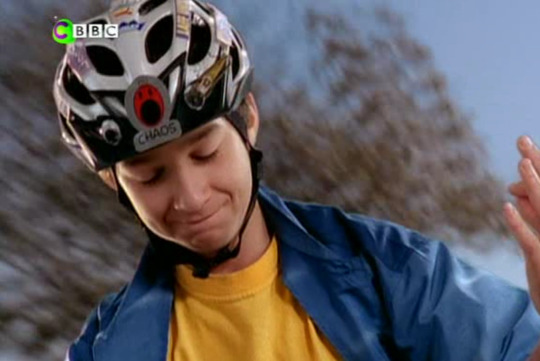
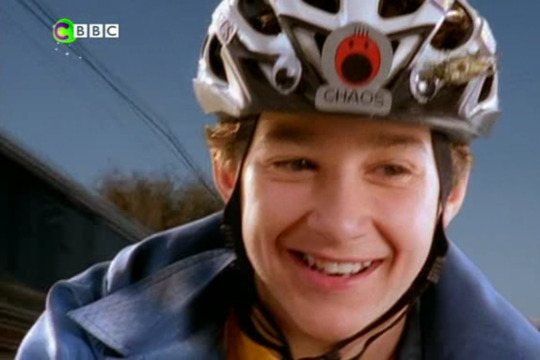
He’s thinking “what is my life”
The scene is used in contrast to the rest of the Stevens family meeting with Eileen’s new image consultant for her Secretary of State campaign. They’re clearly concerned about Louis’ whereabouts and that he’s missing out on some important information. Steve is all “I can’t believe he’s not here yet” and Ren sarcastically says “Yeah, you know.. It’s not like him. He’s usually so considerate” — which hard cuts to Louis screaming “OUTTA MUH WAY!!!” as he zooms past pedestrians with zero regard. Incredible. He even steals a corndog away from the stoner extra Lefkwitz. I’ll never understand Disney’s obsession with corndogs. I feel like they talk about them so much.
Louis shows up late to the meeting with vegetables growing out of his hair, claiming it’s his science fair project. He also says it could be Eileen’s platform: “End world hunger,” which is a great visual. Imagine if we all walked around with food growing out of our heads. The consultant says “Please, tell me this is the wacky next-door neighbor” and in that moment I so wish that Louis was for the family’s sake. He would be the wacky next-door neighbor if this show was about anyone else on their block. This is definitely a sign of Louis becoming more and more outlandish, though. Growing a farm on his head...... like… come on. One thing I’d like to point out is that Christy always makes the actual best facial expressions when reacting to Louis’ craziness.
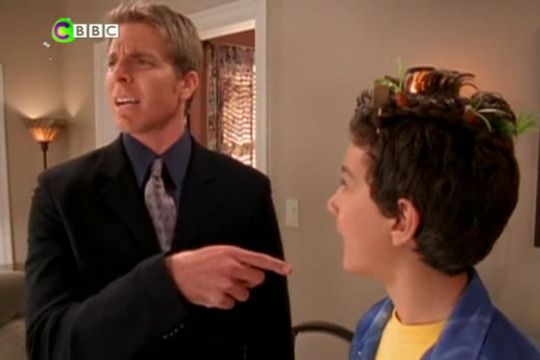
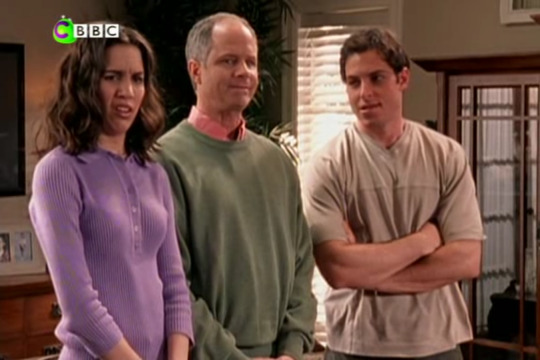
Meme central right there.
This whole scene has a lot of those unflattering close up shots that we saw in Surf’s Up. Both episodes were directed by Paul Hoen. I seriously wonder why he apparently likes those angles so much. It definitely adds to the quirky vibe of the show, but still, I’m not entirely sure it fits. It’s a little distracting to me, almost overkill.
Fast forward to the next day. Eileen is officially announcing her candidacy on the Sacramento Morning News with none other than reporter Cynthia Mills. The image consultant dresses them in the most ridiculous “All American” getups and I have no idea how this guy possibly has a career in image consulting.
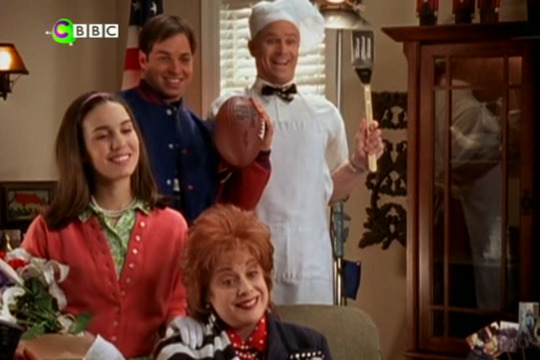
Is this Even Stevens or Leave It To Beaver? (Steve holding that spatula gets me every time.)
Of course, Louis is missing yet again. This time he has yet to make an appearance because he hates the outfit he has to wear. It is… pretty cringy considering the character of Louis Stevens. This is definitely something he’d never wear in a million years.
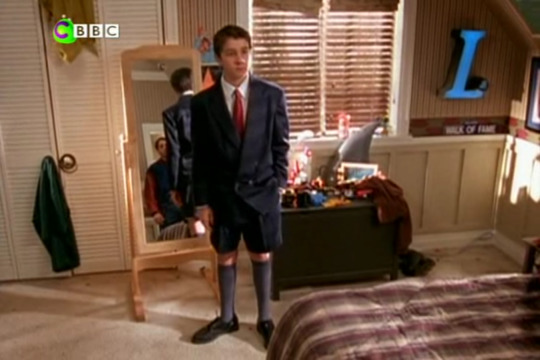
Did Eileen make him clean his room just in case? lol Because it looks immaculate in comparison to the tornado of clothes and junk we usually see.
Donnie literally has to carry him downstairs and Louis shouts “PUT ME DOWN, CRAB GOOSE!” which I’m assuming is an ad-lib. Where does Shia come up with this stuff?! Honestly! God bless him. Cynthia asks him “Is something wrong, little guy?” and all hell breaks loose. This is probably one of Louis’ greatest meltdowns, though. It really made me want to rank this episode way higher. It's absolutely insane! But as great as it is, you kinda get annoyed at the fact he can't even control himself long enough to not embarrass his mother on television like that. He legit destroys the living room and breaks Cynthia’s baby toe. But lines like "I am not a little guy, and these are not my pants" and "I'M NOT SHORTY PANTS KID" make it all worth it. It’s another scene that I just have to embed.
youtube
Larry Beale gives Ren a hard time about the fiasco at school later. He actually throws some solid shade by saying “What a circus! What is your mom running for? The ring master? ‘Cause I just wanted to know.” But, Nelson decides to step up and say “Hey, Snarky! For a guy with a tiny brain, you got a big mouth.” He proceeds to get stuffed in a locker. This is what motivates him to learn how to fight. But, we’ll get to that later.
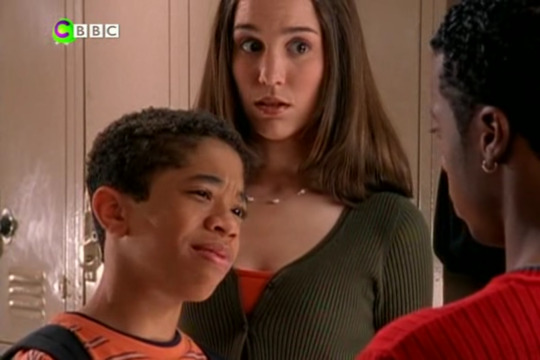
Ren knows that some drama is about to go down.
Eileen, Steve and Donnie are at home watching the news report in horror. Cynthia brought Eileen’s opponent on for an interview and of course they seem like saints in comparison to Eileen’s segment — which basically should’ve started off with “Hi. I’m Louis Stevens, welcome to Jackass!” They desperately change the channel, only to find that the story has been picked up by literally every major news outlet. My personal favorite report:
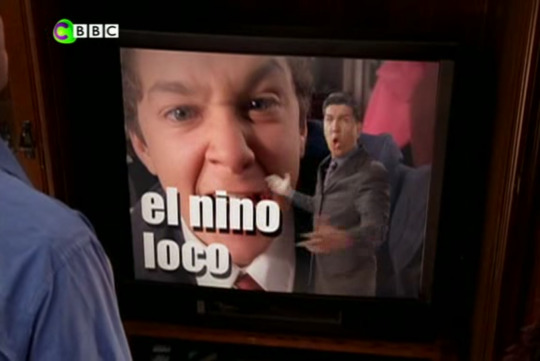
“The Crazy Child” lol.
Louis comes downstairs and seemingly has no idea why they could possibly be upset with him. Eileen starts to feel like everything is her fault since she’s the one who hired the consultant. And Louis just… AGREES WITH HER! He puts it all on her shoulders and takes no responsibility. “Ma, you’re a good kid. You are. You messed up, but it happens… right?” Eileen puts him in his place and explains how much damage control she has to do because of him. This scene makes me so mad. Ugh. Louuuuisssss. He tries to reassure her, saying it’s yesterday’s news. When suddenly Cynthia and a news crew bust through their kitchen window hoping for “The Wild Child” to go berserk again.
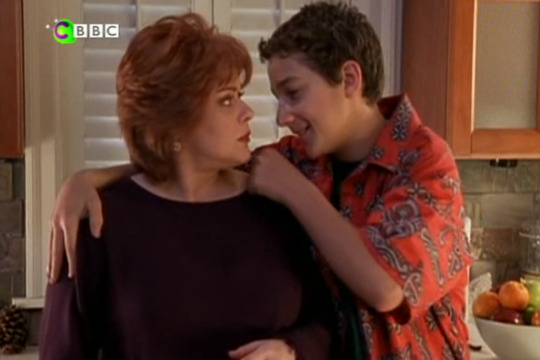
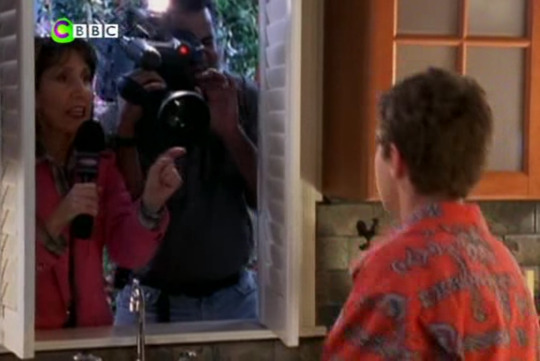
Now Louis finally starts to show genuine remorse, which is always nice and adds that endearing quality to the character. He confides in Ren letting her know that he wants to be the kind of kid who makes his parents proud. I love this. Louis decides he wants to win the science fair to specifically impress Eileen. Ren encourages him by saying she knows him better than anyone and if he sets his mind to something, he’ll do a great job. This is so true.
We see Louis working on his new, elaborate project for the science fair — The “Eco-Bot 3000.” He’s not exactly sure what it does yet, though. Ren is impressed and tells Eileen that he’s been working day in and day out on the project and that she should really go to the fair. The only issue is that Eileen scheduled her damage control press conference for the same day.
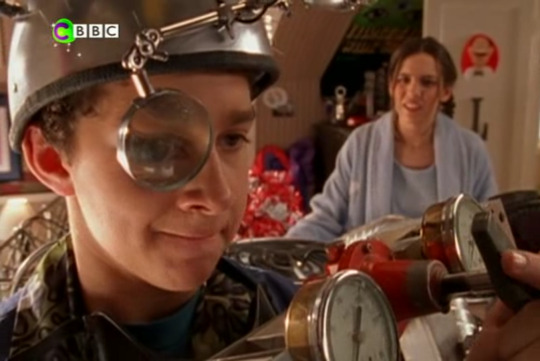
So, yeah. Nelson wants to learn how to fight and enlists Donnie’s help. Donnie knows the kid doesn’t stand a chance, so he teaches him some bogus ancient pinky finger trick he dubs “Ka-Ting.” That poking someone in a certain spot will reduce them to a pile of jelly on the floor. Okay. Nelson falls for it though and thinks he’s suddenly become some sort of blackbelt. He starts intimidating kids at school with his pinkies. How embarrassing. Let’s just wrap this subplot up now, shall we? Ren finds out about what Donnie did, so she tricks Nelson into thinking he’s too powerful and needs to put his pinkies away for good. He falls for that, as well. What a gullible guy. The end, lol. It’s an underwhelming subplot and feels like a total waste of time.
One of the craziest things ever happens at Eileen’s press conference. Cynthia asks her "Is there any truth to the rumor you have sent him off to a desert work camp?" Holy crap. Did the writers just predict the freaking future?!

I wonder if Shia was already confirmed for Holes and they wrote that in as a little joke?! This episode aired in 2001. The movie was released in early 2003, so it obviously must’ve filmed in 2002. It’s a possibility! Suddenly the entire movie has become a spin-off/Even Stevens AU fanfiction of Louis being sent off to camp for terrible behavior. Let’s be real, though… He WOULD become the leader of the D-Tent pack. Holes will forever be a Louis Stevens at Camp Greenlake story now. Well.. minus the whole “no-good-dirty-rotten-pig stealin’-great great grandfather” mumbo jumbo. And the fact that his name is Stanley Yelnats. Annnnd has a completely different life story. Just forget that. Anyway, I just thought this bit was borderline eerie!! haha. It’s too coincidental.
Cut to the science fair. The "Eco-Bot 3000” ended up being an automatic recycling machine and can/bottle crusher. HE'S SO TALENTED!!! I swear to god. If there was ever an Even Stevens reboot, Louis needs to have a job in engineering and do stand up comedy on the side or something. Wow.
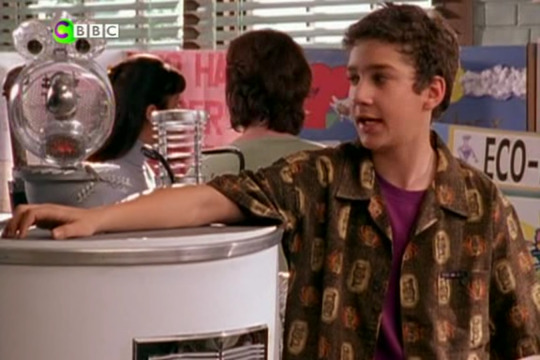
Eileen ditches the press conference to be a good mother and support Louis at the fair. Everything is great and amazing and he wins first place! Until he demonstrates how it works to Cynthia Mills and the news crew and accidentally has it crush a full carton of milk — which explodes everywhere and the system runs haywire. There was a crap ton of milk in there. How did he not feel that when he lifted the carton??? He’s smart enough to create this machine from scratch but too dumb to realize the carton is full of milk?! Logic. The Eco-Bot pretty much becomes an extension of Louis’ personality we saw earlier, and terrorizes the fair. And… that’s it.
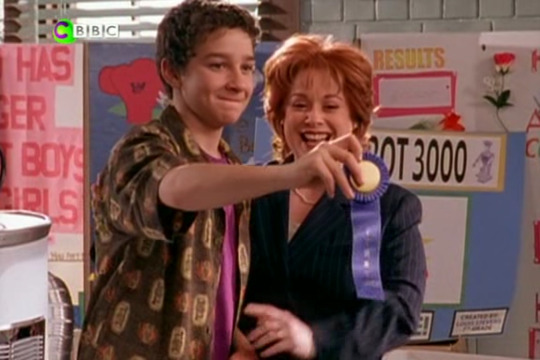
Look how proud he was, though… :(
This one doesn't have much of a definitive ending. Or maybe it does, but it's just not very satisfying because Louis still basically loses in the end. The thing he worked so hard on ultimately goes wrong for him… on live TV… again. I don't like that. It always leaves me feeling upset and a little empty, tbh. But a memorable moment like the Shorty Pants freakout, and seeing Louis genuinely want to be a better kid redeem it for me. I couldn’t care less about this Nelson subplot, though.
Thanks for reading! And side note: Today is actually Shia’s 31st birthday!! Aww. Time flies. Go wish the king himself a good one.
Twitter | Facebook | Instagram
#rank#even stevens#shia labeouf#louis stevens#louis plot#ren stevens#nelson minkler#eileen stevens#cynthia mills#season 2#disney channel#old disney#nostalgia#tv show#tv review#holes 2003#comedy#louis the engineer
5 notes
·
View notes
Text
The Celebrity Perv Apology Generator is hilariously, depressingly accurate.
Why are celebrity apologies so ... bad? Like ... head-scratchingly bad?
Harvey Weinstein prefaced his by saying that he "came of age in the '60s and '70s, when all the rules about behavior in workplaces were different." Louis C.K. noted that he "never showed a woman [his] dick without asking first." Kevin Spacey felt the need to say, "I choose now to live as a gay man."
For having access to some of the best public relations professionals in the world, it seems celebrities just can't seem to put together a statement of contrition that actually comes off as genuine.
Kevin Spacey and Harvey Weinstein have both recently released less-than-stellar apologies for truly reprehensible acts. Photos by Christopher Polk/Getty Images, Photo by Drew Angerer/Getty Images.
Author Dana Schwartz jokingly tweeted plans to start "a small business ghostwriting half-hearted apologies for celebrity pervs." Within 24 hours, it became a reality.
Teaming up with designers Rob Sheridan and Scott McCaughey, Schwartz launched the Celebrity Perv Apology Generator, where anyone can go and get their very own half-assed apology for free. It's satire at its best, reflecting non-apologies back on the celebrities who give them.
"Please consult for all your celebrity perv apology needs," Schwartz tweeted.
The Celebrity Perv Apology Generator is up and running. Please consult for all your celebrity perv apology needs: https://t.co/1r7SwV2MMs
— Dana Schwartz (@DanaSchwartzzz) November 20, 2017
In cycling through a few results on the apology generator, some familiar phrases popped up.
"As someone who grew up in a different era, the allegations against me are troubling," reads one of the responses.
"As someone who grew up in a different era, the allegations against me are troubling. I comforted myself by saying that at least I asked before I 'honked' her boobs and demanded she watch me shower, and of course now I realize my behavior was wrong. In conclusion, I'm not saying the victim is a 'liar,' I'm just saying 'she's not telling the truth about the thing that happened because maybe it didn't even happen.'"
"As a father of daughters," begins another.
"As the father of daughters, I feel tremendously guilty now that the things I did have been made public. I imagined that any woman would have been thrilled to see a tiny penis peeking out from below my pasty, middle-aged paunch like the head of a geriatric albino turtle moments from death, and of course now I realize my behavior was wrong. In conclusion, I will wait 2-3 years before reappearing in film and TV and just sort of hope you all forget about this."
The common thread in each of these results is that the words "I'm sorry" are nowhere to be found, instead, replaced by a litany of excuses.
"As a male feminist, harassment is completely unacceptable — especially when people find out about it. At the time I believed that my sociopathic manipulation of the 22-year-old in my office was consensual, and of course now I realize my behavior was wrong. In conclusion, I will delete my Twitter account because I hate to see people who are mad at me."
"I found myself getting really exacerbated by the cycle of accusation, blowback, and apology," Schwartz explains in a Twitter direct message.
"The apologies just became these rote boxes to check, like a whole new genre of writing complete with its own cliches and recycled phrases," she says.
The generator was born out of the idea that the types of apologies we've been seeing from celebrities are so generic that they might as well be pre-written or even automated.
"At the time, I said to myself that what I did was OK because I never showed a woman my dick without asking first, which is also true," comedian Louis C.K. wrote in a statement to the New York Times. Photo by Kevin Mazur/Getty Images for The Bob Woodruff Foundation.
Apologies are important, so what makes a good one?
According to Schwartz, a good apology must be earnest, specific, and remorseful. "Actually saying, 'I'm sorry' helps, and not making excuses," she writes, adding that the best apologies would have happened years ago and not just when someone's professional reputation is on the line.
A 2014 paper by Stanford psychologist Karina Schumann, published in the Journal of Experimental Social Psychology suggests that a good apology actually has eight specific parts:
The words "I'm sorry."
The words "I was wrong," or some variation thereof.
An acknowledgment of the action being apologized for.
An honest description of the action without blaming others.
An emphasis on understanding how the wronged person has been hurt.
An outline of plans to make amends for the damage the was done.
An assurance that what's being apologized for won't happen again.
An ask for forgiveness.
Not every apology will be accepted, and that's OK. We all make mistakes in our lives; we all have moments or actions that have probably necessitated an apology or two along the way. Not every apology has to be a big public show — in fact, most genuine apologies aren't.
In an ideal world, the offending action wouldn't have happened in the first place. This isn't that world, however. People make mistakes, and when they do, they should say they're sorry — they should just make sure it doesn't sound like something you'd find on Schwartz's website.
More From this publisher : HERE ; This post was curated using : TrendingTraffic
=> *********************************************** Originally Published Here: The Celebrity Perv Apology Generator is hilariously, depressingly accurate. ************************************ =>
The Celebrity Perv Apology Generator is hilariously, depressingly accurate. was originally posted by 26 VT Business News
0 notes
Text
The Celebrity Perv Apology Generator is hilariously, depressingly accurate.
Why are celebrity apologies so ... bad? Like ... head-scratchingly bad?
Harvey Weinstein prefaced his by saying that he "came of age in the '60s and '70s, when all the rules about behavior in workplaces were different." Louis C.K. noted that he "never showed a woman [his] dick without asking first." Kevin Spacey felt the need to say, "I choose now to live as a gay man."
For having access to some of the best public relations professionals in the world, it seems celebrities just can't seem to put together a statement of contrition that actually comes off as genuine.
Kevin Spacey and Harvey Weinstein have both recently released less-than-stellar apologies for truly reprehensible acts. Photos by Christopher Polk/Getty Images, Photo by Drew Angerer/Getty Images.
Author Dana Schwartz jokingly tweeted plans to start "a small business ghostwriting half-hearted apologies for celebrity pervs." Within 24 hours, it became a reality.
Teaming up with designers Rob Sheridan and Scott McCaughey, Schwartz launched the Celebrity Perv Apology Generator, where anyone can go and get their very own half-assed apology for free. It's satire at its best, reflecting non-apologies back on the celebrities who give them.
"Please consult for all your celebrity perv apology needs," Schwartz tweeted.
The Celebrity Perv Apology Generator is up and running. Please consult for all your celebrity perv apology needs: https://t.co/1r7SwV2MMs
— Dana Schwartz (@DanaSchwartzzz) November 20, 2017
In cycling through a few results on the apology generator, some familiar phrases popped up.
"As someone who grew up in a different era, the allegations against me are troubling," reads one of the responses.
"As someone who grew up in a different era, the allegations against me are troubling. I comforted myself by saying that at least I asked before I 'honked' her boobs and demanded she watch me shower, and of course now I realize my behavior was wrong. In conclusion, I'm not saying the victim is a 'liar,' I'm just saying 'she's not telling the truth about the thing that happened because maybe it didn't even happen.'"
"As a father of daughters," begins another.
"As the father of daughters, I feel tremendously guilty now that the things I did have been made public. I imagined that any woman would have been thrilled to see a tiny penis peeking out from below my pasty, middle-aged paunch like the head of a geriatric albino turtle moments from death, and of course now I realize my behavior was wrong. In conclusion, I will wait 2-3 years before reappearing in film and TV and just sort of hope you all forget about this."
The common thread in each of these results is that the words "I'm sorry" are nowhere to be found, instead, replaced by a litany of excuses.
"As a male feminist, harassment is completely unacceptable — especially when people find out about it. At the time I believed that my sociopathic manipulation of the 22-year-old in my office was consensual, and of course now I realize my behavior was wrong. In conclusion, I will delete my Twitter account because I hate to see people who are mad at me."
"I found myself getting really exacerbated by the cycle of accusation, blowback, and apology," Schwartz explains in a Twitter direct message.
"The apologies just became these rote boxes to check, like a whole new genre of writing complete with its own cliches and recycled phrases," she says.
The generator was born out of the idea that the types of apologies we've been seeing from celebrities are so generic that they might as well be pre-written or even automated.
"At the time, I said to myself that what I did was OK because I never showed a woman my dick without asking first, which is also true," comedian Louis C.K. wrote in a statement to the New York Times. Photo by Kevin Mazur/Getty Images for The Bob Woodruff Foundation.
Apologies are important, so what makes a good one?
According to Schwartz, a good apology must be earnest, specific, and remorseful. "Actually saying, 'I'm sorry' helps, and not making excuses," she writes, adding that the best apologies would have happened years ago and not just when someone's professional reputation is on the line.
A 2014 paper by Stanford psychologist Karina Schumann, published in the Journal of Experimental Social Psychology suggests that a good apology actually has eight specific parts:
The words "I'm sorry."
The words "I was wrong," or some variation thereof.
An acknowledgment of the action being apologized for.
An honest description of the action without blaming others.
An emphasis on understanding how the wronged person has been hurt.
An outline of plans to make amends for the damage the was done.
An assurance that what's being apologized for won't happen again.
An ask for forgiveness.
Not every apology will be accepted, and that's OK. We all make mistakes in our lives; we all have moments or actions that have probably necessitated an apology or two along the way. Not every apology has to be a big public show — in fact, most genuine apologies aren't.
In an ideal world, the offending action wouldn't have happened in the first place. This isn't that world, however. People make mistakes, and when they do, they should say they're sorry — they should just make sure it doesn't sound like something you'd find on Schwartz's website.
More From this publisher : HERE ; This post was curated using : TrendingTraffic
=> *********************************************** Read Full Article Here: The Celebrity Perv Apology Generator is hilariously, depressingly accurate. ************************************ =>
The Celebrity Perv Apology Generator is hilariously, depressingly accurate. was originally posted by 28 VT Celebrity News
0 notes
Text
Our Fast Fashion Habit Is Killing the Planet
“The clothing industry is the second-largest polluter in the world…second only to oil,” Eileen Fisher, founder of the eponymous line of clothes, told an NYC audience in 2015. “It’s a nasty business…it’s a mess.” This means that our fashion factories are leading the pollution rank while meeting our most demand: clothing. And every day we wear clothes choosing to express ourselves and how we want to be seen and observed. The fashion industry has evolved over the years as other lifestyle industries in the world. Fashion has become fast rising from the regular 100% cotton wears to chemically produced fibers to make textiles. Fast fashion is effectively expended, and dispensable styles produced and priced at extremely low rates and do not last for longer than a season. As it is now our desire to wear on demand has brought in the use of poisonous chemicals into the surroundings to the point that the air is polluted resulting in more wastes. When we shop, we get everything so neat, not bothering about what it has taken the producer to make that new dress, shirt, or that box of trendy wears you so much love. Presently over 60 percent of fabric fibers are synthetics, Derived from fossil fuels which simply means that if and when our clothing is disposed of and ends up in a garbage lot, it will not fester. In the future, archaeologists will look up land space taken over by nature and find remains of Louis Vuitton.
Overflowing landfills with fashion wastes
Over the last ten years, demand for fast fashion rose rapidly while consumers have become more addicted to low-cost, disposable fashion. This in turn as made fast fashion enterprises relentless as over 100 billion new garments are produced from new fibers every single year. In the habit of being trendy and stylish, we buy 400 percent more clothing every year. Sadly, most of that fast fashion wind up in the trash. Also, before the new outfit gets to the stores, the fashion houses make a lot of demand and changes in the processes involved. The first step is the designing of the item and samples are made. But the samples are not usually produced with just that textile that makes it to the store. Fashion houses design and order different types of fabric and patterns and they order more than enough quantity of each one to make all the clothes they need. When these designs are ready, the fashion industry selects the ones that have been selected while leaving the other samples, a pile of clothing to waste away. There are over 1,500 workers in the fashion industry. And they use over 30,000 clothing items for one piece of clothing with very limited time to fill an order. So, in the event of any mistake such as caught up a zipper or the clothing the fashion house returns the whole order, and everything gets dumped and wasted. The fashion industry has been recorded as one of the highest water consuming industries in the world because producing jeans requires 40 gallons of water. Kelly Drennan, the founder of Fashion Takes Action has also emphasized that fast fashion is not going away. So, if we continue to consume as much clothing as we do today, that means we will continue to have fashion waste. To reduce clothing wastage, consumers need to work on behavior. Old pairs of clothing can also be donated to factories that recycle fiber for padding and stuffing.
Fast fashion pollutes the environment
This is usually through the tons of sometimes harmful chemicals used on fiber-producing plants We all know clothes are made from animals and plants, but the arrival of technology introduced the use of pesticides on plants that are used in manufacturing textile and petrochemicals such as synthetic fibers, polyesters. Plants such as cotton cover 2.4% of the land surface while being treated with 6% of pesticides. They are extremely sprayed with a heavy amount of harsh pesticides to eliminate anything that might destroy the plants. Also, the growth of the bamboo requires no fumigation or the use of pesticides except when bamboo is used in textile making. The spinning of the bamboo into textile usually requires a breakdown of chemicals which have several negative effects on humans. This process continuous when clothes are disposed of as the chemicals sink into the land or evaporate into the atmosphere. These chemicals also sink into our groundwater and flow into streams, rivers, and the ocean. This is a cycle showing that the local use of pesticides on fiber-producing plants affects all waterways while dissolving into the ocean and killing the plants and animals in them. These have had a catastrophic impact on the health and economy in most places such as West Africa where cotton is mostly grown. Once they are in the environment, people easily absorb them resulting in poisoning, cancer.
Chemical Emissions
One of the most destructive ends our high taste for clothes on-demand led us to is also the pollution of the air in the atmosphere. As small as any fashion industry, 150 billion-plus articles of clothing are produced yearly using coal power which is why the textile industry is responsible for 10% of all carbon emissions in the world. A worker who has worked for over forty years in all parts of the fashion industry once mentioned that air has extremely been polluted. This is because she noticed that the sky always having a thick grey covering where she had recently worked as a quality control officer. Most workers were unable to breathe properly because they had respiratory problems. They were made to remain indoor. On a global scale, the factories producing our clothes are contributing to climate change by their releasing of chemicals such as carbon dioxide into the air.
Leather Tanning
In clothing production, the processes of leather-tanning involve harsh chemicals. Many of these chemicals used in the tanneries are washed down the drain and then flow into many local rivers. These chemicals give leather workers skin and respiratory diseases, and much of the local community suffers from chronic fevers, skin diseases, aches, dizziness, nausea, and diarrhea. Most of the local water sources usually used for curing leather and presently they are so polluted that nothing lives in them anymore. Shirin Akhter, the founder of an NGO called Karmojibi Nari (Working Women), “We are a country of rivers, but we have no water to drink” explaining the chronic effects of leather tanning on their water sources in their locality. These chemicals give leather workers skin and respiratory diseases, this explains why most of the local community suffers from chronic fevers, skin diseases, aches, dizziness, nausea, and diarrhea. Most of the products of leather tanning meet the endless and high demand for leather shoes, belts, purses, and jackets by the Western world. This explains that people who are involved in leather tanning for export purposes are poor as they carry out these processes in a poisonous environment.
Underpaid Workers
Sadly, the fashion industries are not only wasting resources and causing air, land, and water pollution. They are also responsible and widely known for subjecting the workers to terrible working conditions. Most textile workers are women and children and they are always extremely underpaid. It is so unfortunate that only two percent of fashion industries source their workers from suppliers that pay a living wage. Apart from the fact they are underpaid, they also work in dehumanizing and harmful environments usually referred to as sweatshops. Children are also employed in poor working conditions revealing that child labor is a practice in the fashion industry. The way we produce and consume our products and services overlooks the pain we cause our fellow human beings. In conclusion, it is very crucial to be mindful of our many actions and how they affect the environment in general. Self-discipline and consciousness will also help to reduce wastage of resources without stopping our modest demand for fashion items. All of the adverse effects of fast fashion in our environment happens mainly because of our fashion sense and thirst so that we can wear trendy clothes and the latest fashion. It is also very critical to bear in mind that in the bid to stylishly please our fashion minds, we should endeavor to shy away from participating in a practice that destroys both the present and the future of our environment. Sustainable fashion should not just about just be a charity project and donations but also a significant change from the norm. It has to be the norm itself. Sustainable fashion is important because even though fast-fashion brands may not have the intention to make their design and clothing to last, they are already struggling to become an essential part of the fossil record. It is also important to know that some fashion industries are already taking active parts in sustainability. They now engage in cleaning and reselling used clothes at lower prices, and also introducing a clothing rental program that enables a shared economy. Read the full article
0 notes
Text
7 Artists Reinventing the Ancient Art of Mosaics
From the floors of ancient Pompeii to the walls of the New York subway, mosaics have been a feature of urban life for thousands of years. Beloved by hobbyists and DIYers, these assemblages, typically created by arranging pieces of glass or stone, are often categorized merely as craft, reducing their appeal to artists who would prefer to avoid those associations.
Yet there are others, not so easily dissuaded by the medium’s workaday reputation, who have approached it with an inventive spirit. The famously experimental painter Jack Whitten explored the form by creating tesserae, or mosaic pieces, from slices of dried paint that he shaped into sculptural forms resembling stone or tile. While many of the artists that follow don’t exclusively make mosaics, each is determined to push this often intransigent medium in a fresh direction.
Jim Bachor
B. 1964. Lives and works in Chicago

Jim Bachor, LIAR, 420 North Wabash, Chicago, May 2017. Courtesy of the artist.
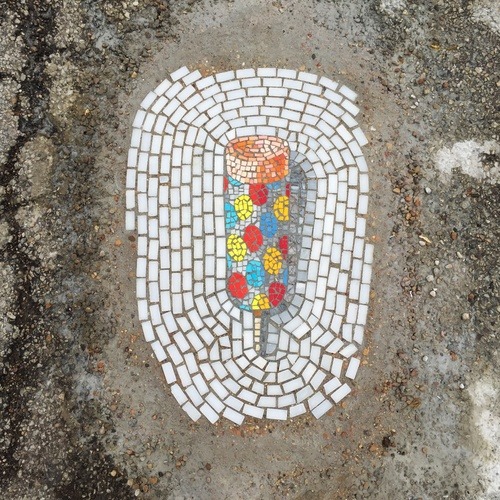
Jim Bachor, Push Up, 835-849 North Hudson Avenue, Chicago, May 2015. Courtesy of the artist.
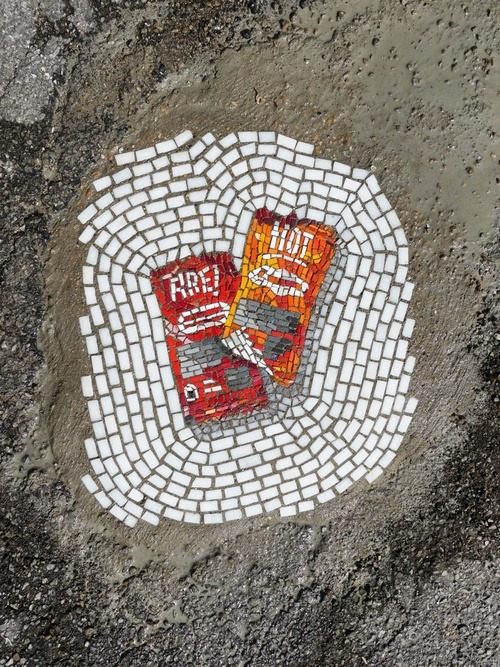
Jim Bachor, Hot Sauce Packets, 3650 North Hermitage, Chicago, May 2017. Courtesy of the artist.

Jim Bachor, Bomb Pop, 443-449 North Armour Street, Chicago, April 2015.
If you’ve spent any time traversing the city of Chicago on foot, you may have stumbled across one of Bachor’s pieces. They’re installed in potholes across the city, brightening the pavement with images of everything from rocket pops to tulips to Burberry plaid.
Bachor is impressed by the long history of mosaics, but he also resists it. “Mosaics carry a lot of baggage. There are entrenched, preconceived ideas as to what they are,” he continues. “My approach is to try and drag mosaics into the 21st century by exploring contemporary subject matter, modifying techniques, and rethinking the process when I can.” Bachor’s interest in advancing the medium has led him to create mosaics that are meant to be viewed with 3D glasses and others that incorporate the actual material of the object they depict—Starbucks coffee or carbonized Twinkies mixed into the mortar in which the piece is set.
But it was the longevity of mosaics that first caught Bachor’s attention during a visit to Pompeii in the 1990s. “I can still remember the guide saying that marble and glass don’t fade, so the artwork looked essentially like the artist intended almost 2,000 years ago,” he says. “It’s the thought that drives my work to this day—the idea of making an enduring mark in this world, however slight.”
Isidora Paz López
B. 1975. Lives and works in Hinterweidenthal, Germany

Mosaic by Isidora Paz López. Courtesy of the artist.
López is known for her ambitious public art projects that have covered thousands of feet of her native Chile in mosaic tile. She loves the form because it makes an impact on the community and gives her a chance to go big. “With mosaics you can make meticulous work with tiny pieces and precious little details, but you can also use big pieces and make huge things, like murals, interventions in architecture, and urban art projects,” López says.
In 2012, she assembled a team to create mosaics depicting native flora and fauna on over 80 pillars along a metro train line in Puente Alto, a suburb of Santiago, Chile. Then, in 2014, López went even bigger: She organized the 1st International Urban Mosaic Intervention, a two-week-long event that brought together some 80 artists from 22 countries to create a massive mosaic on the facade of a municipal building in Puente Alto. López sketched out a basic design on the wall in chalk, but each artist was free to choose whether to follow her lead, to modify the design, or to deviate from it completely. The biggest challenge of the project was making the seams where one artists’ work met the next feel harmonious, but in the end, López was pleasantly surprised. “The result was much better than expected,” she says. “Friendly collaboration, compromise, and the talent of the artists made it possible to create something cohesive and beautiful. It was really magical.”
The generous notion of a mosaic as a catalyst for communal bonds, and a site where disparate components can meet, is at the heart of López’s practice. “You can use a wide variety of materials, from the most luxurious ones to recycled objects or materials collected from nature,” she says. “I mainly use ceramic tile, but I love to experiment and mix it with other things.”
Benjamin Lowder
B. 1974. Lives and works in Otter Lake, Illinois
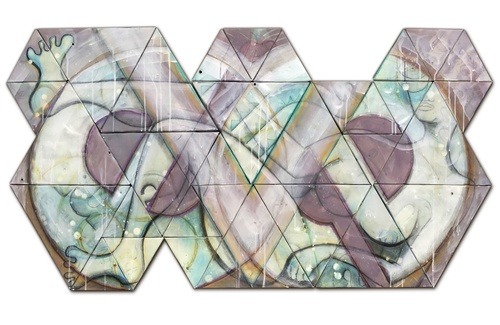
Benjamin Lowder, Eve (from his “Myth, Math & Magic” series), 2017. Courtesy of the artist.
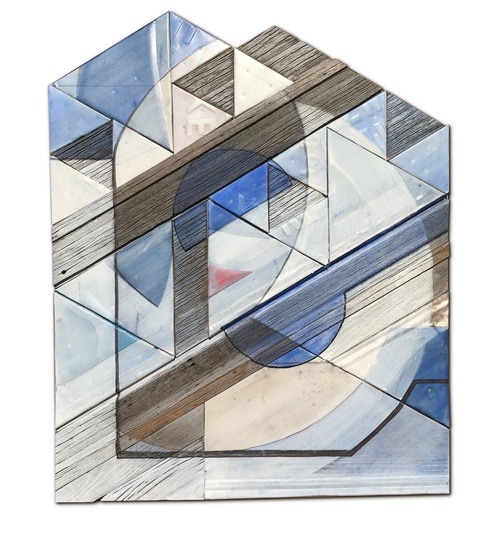
Benjamin Lowder, El (from his “Myth, Math & Magic” series), 2017. Courtesy of the artist.
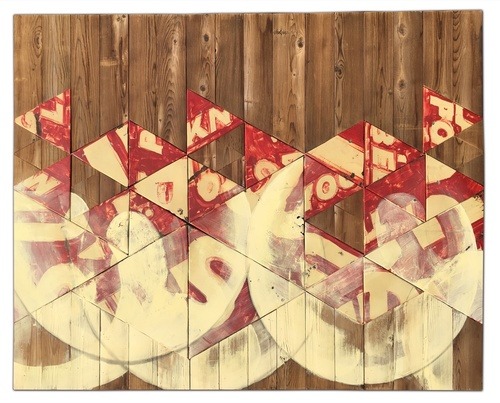
Benjamin Lowder, Formation, 2017. Courtesy of the artist.

Benjamin Lowder, Kether, Chokmah & Binah (from his “Myth, Math & Magic” series), 2013. Courtesy of the artist.
Rather than the traditional glass or stone, Lowder’s mosaics are composed of reclaimed wood, often sourced from barns, and metal signage—materials that reflect his Midwestern milieu. In some, bits of hand-lettered typography appear in a reorganized jumble. It’s like looking at an old country store through a kaleidoscope. And yet, references to religious icons and celestial phenomena suggest a sort of spiritual geometry, taking Lowder’s compositions beyond remixed Americana. They’re more reminiscent of the diagrams in illuminated medieval manuscripts.
Lowder’s current body of work uses triangles of reclaimed wood and vintage metal signs as the base unit for his mosaics. “Many of my aesthetic choices about how the triangles fit together in my works are based on the proportions and patterns of natural growth structures,” the artist explains. He’s interested in “self-similarity,” a mathematical phenomenon sometimes found in the natural world, in which each individual part is a nested reflection of the whole—as is the case with ferns, snowflakes, and cauliflower. It’s easy to see why mosaics would offer the ideal medium to explore these relationships.
Jason Middlebrook
B. 1966. Lives and works in Hudson, New York

Jason Middlebrook, Underlife, 2010-13. Courtesy of the artist.
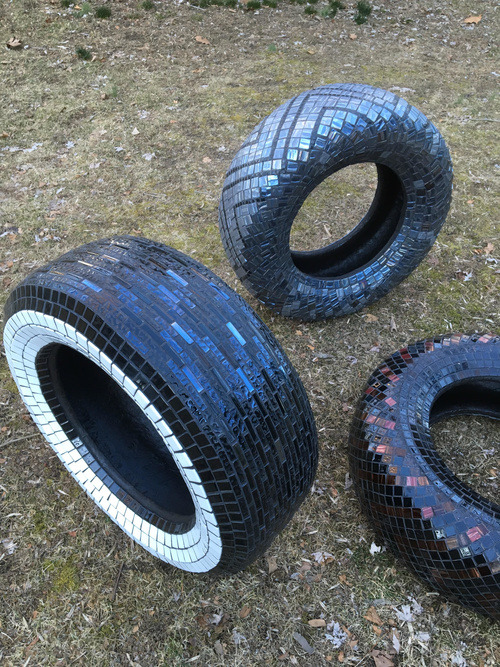
Work by Jason Middlebrook. Courtesy of the artist,
Middlebrook’s mosaics can take on mythic proportions, as in the case of his giant tentacle-like root forms covered in glass or stone. “I started working with mosaics because I wanted a material that was painterly yet could also act as a skin for sculpture,” Middlebrook explains. His monumental outdoor work Underlife (2010–13) glitters with glass tile, making the work seem almost animate, a hungry creature on the hunt.
Middlebrook cites Louis Comfort Tiffany and Antoni Gaudí as inspirations for his work, particularly in terms of their committed attention to detail and meticulous techniques. Yet the enduring association of mosaics with craft irks him. “I don’t like that mosaics are labeled ‘craft,’ so the challenge is to make them into a contemporary medium,” he says.
Middlebrook’s work has changed dramatically from when he first arrived in New York in the mid-1990s to participate in the Whitney Independent Study Program. “I was making air freshener sculptures and drawings of muscle cars—think Richard Prince meets Robert Smithson,” he says. Those works were a far cry from the mosaic of delicate flowers that Middlebrook created in 2011 for the Avenue U subway stop in Brooklyn. “I guess I got seduced by the material and its generous possibilities,” he concludes.
Takako Hirai
B. 1975. Lives and works in Ravenna, Italy
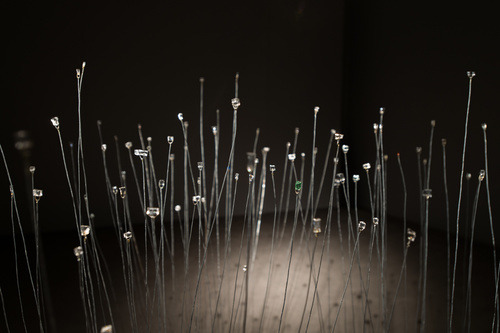
Takako Hirai, Giardino segreto (secret garden), 2017. Photo by Giampaolo Solitro. Courtesy of the artist.

Takako Hirai, La mia tana (my hideout), 2017. Photo by Giampaolo Solitro. Courtesy of the artist.
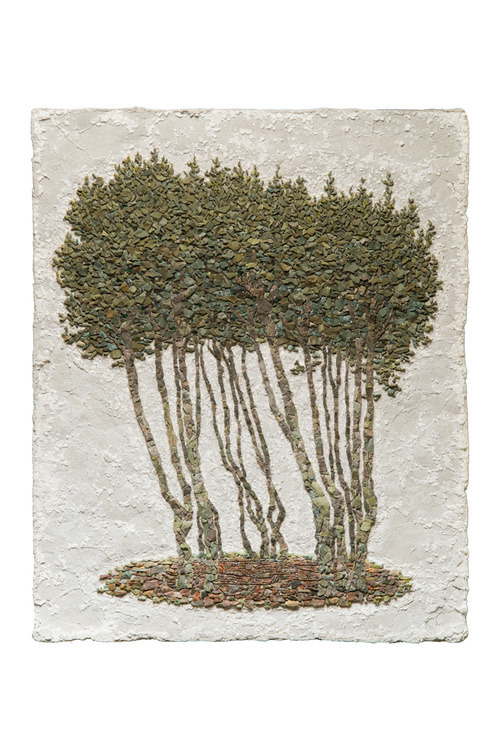
Takako Hirai, La mia tana (my hideout), 2017. Photo by Giampaolo Solitro. Courtesy of the artist.
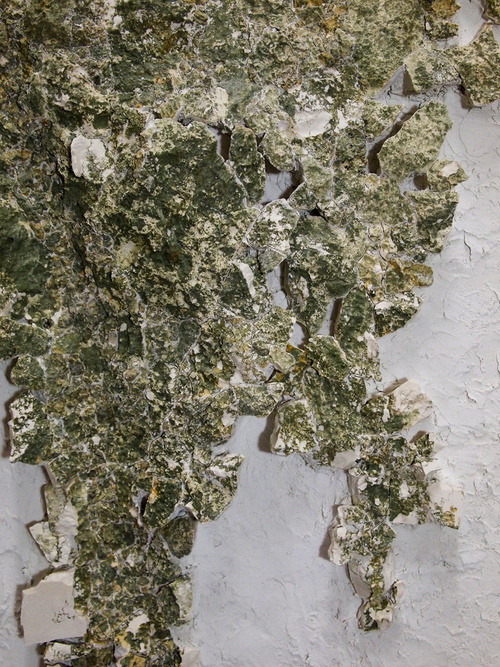
Takako Hirai, Vene (veins), 2017. Courtesy of the artist.
Hirai first fell for mosaics while on a university trip to Rome as a painting student in 1997. Originally from Kumamoto, Japan, Hirai returned to Italy in 2003 to study mosaic art, then moved to Ravenna permanently in 2005. At first, Hirai worked in a mosaic studio and saw the practice as more of a day job, albeit one that could inform her painting. “I did not know anything about mosaics, or even any mosaic artists,” she says. “I discovered the possibilities for artistic expression while training.”
Hirai’s work, with its natural shades, gentle gradations of color, and irregular stones, feels earthy. She often captures natural moments of growth or change—a sprout breaking the surface of the soil, or wind blowing in the leaves of a tree. Other, more abstract compositions mimic the sparkle of light on water or the impression of a crater in stone. Hirai emphasizes that the cracks between the tesserae are an important avenue for communicating meaning. “I utilize the space between fragments and hide feelings there that I want to keep secret,” the artist says. “But I also want that feeling to appear in the landscape when you look at my work.”
Enzo Valentinuz
B. 1946. Lives and works in Romans d’Isonzo, Italy
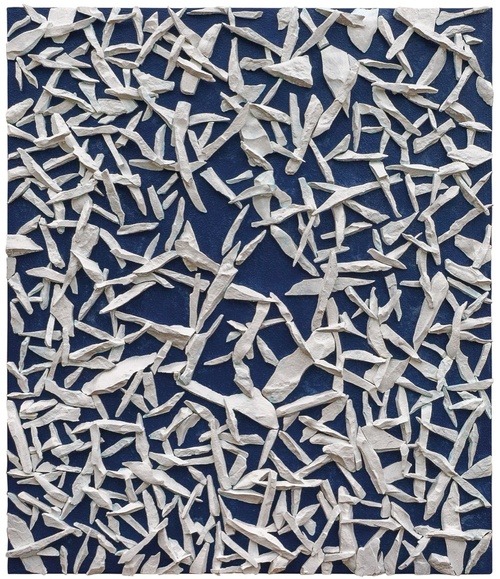
Enzo Valentinuz, Hawthorn, 2013. Courtesy of the artist.
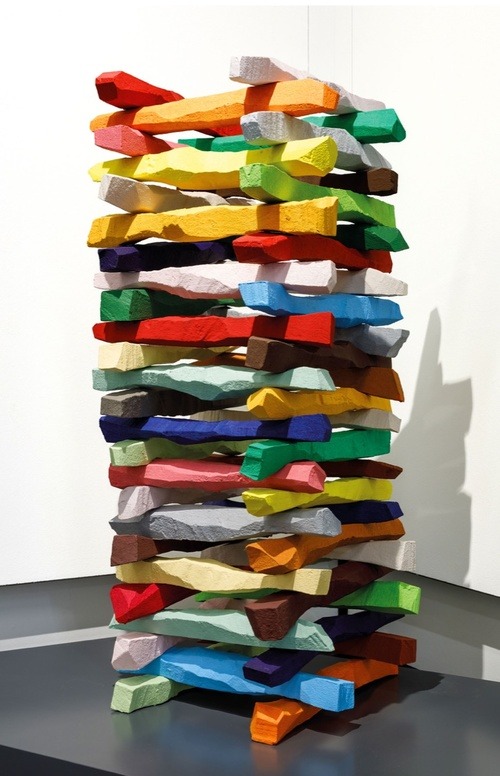
Enzo Valentinuz, Building, 2012. Courtesy of the artist.
Valentinuz’s art is inseparable from the Friuli-Venezia Giulia region of northern Italy. His fascination with this part of Italy stems from the area’s striking beauty as well as its dark history; the Italian border where he was born and still lives was the site of bloody battles during World War I.
Originally trained as a fresco painter at the Academy of Fine Arts of Venice, Valentinuz would have an encounter with nature that ultimately turned his attention toward mosaics. Fifteen years ago, during a walk on the Karst plateau—a rocky plain that extends from northeastern Italy to western Slovenia—he noticed the way that the beauty of rocks contrasted with the landscape’s painful history.
“I felt the violence of cannons and mortars as the origin of the splinters falling all around. It occurred to me to use those broken stones, which had seen or felt the fighting, as a pictorial element in my artworks,” he explains. Rough-hewn, often painted, and arranged in orderly grids, circles, or towers, Valentinuz’s stones suggest modern-day menhirs or collections of raw pigments sorted according to color.
Cassandra Emswiler Burd
B. 1983. Lives and works in Dallas, Texas
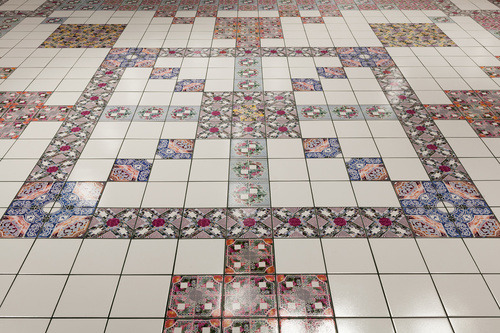
Cassandra Emswiler Burd, My dreams will pull you through this garden gate, 2014. Photo by Kevin Todora. Courtesy of the artist and Dallas Contemporary.
You might argue that Burd doesn’t make mosaics at all. The Texas-based artist uses whole tiles, rather than broken or cut ones, to make her work. Yet she employs them to the same end: creating patterns and images via a process of assemblage. Burd’s compositions look like one thing at a glance, and quite another upon closer inspection. Her tiles are printed with photographs of her family, home, and environment, but at a distance they appear to be the quotidian patterns you might find on a kitchen floor.
Burd is interested in how tile can create architectural space as well as how it can hold memories. “The history or conditions of the site in which the tile is installed are always a primary concern,” she says. “I’ll often incorporate photos of the site into the design, or the graphic motif might derive from its architectural features or commemorate a person connected to the place.”
Among her interests and influences, Burd lists French philosopher Gaston Bachelard and the history of landscape, gardens, and vernacular architecture, and her work reflects this mix of theoretical concerns and functionality. Since buying a home, she’s been installing her own tile in the bathrooms and kitchen. “This leap into domestic space has been exhilarating,” Burd reports. “The tiles are inspired by the pattern on the kitchen floor of my childhood home. So being able to bring them into the space of my first home as an adult is like the completion of some sort of sacred loop—it’s very special to me.”
from Artsy News
0 notes
Text
The Celebrity Perv Apology Generator is hilariously, depressingly accurate.
Why are celebrity apologies so … bad? Like … head-scratchingly bad?
Harvey Weinstein prefaced his by saying that he “came of age in the ’60s and ’70s, when all the rules about behavior in workplaces were different.” Louis C.K. noted that he “never showed a woman [his] dick without asking first.” Kevin Spacey felt the need to say, “I choose now to live as a gay man.”
For having access to some of the best public relations professionals in the world, it seems celebrities just can’t seem to put together a statement of contrition that actually comes off as genuine.
Kevin Spacey and Harvey Weinstein have both recently released less-than-stellar apologies for truly reprehensible acts. Photos by Christopher Polk/Getty Images, Photo by Drew Angerer/Getty Images.
Author Dana Schwartz jokingly tweeted plans to start “a small business ghostwriting half-hearted apologies for celebrity pervs.” Within 24 hours, it became a reality.
Teaming up with designers Rob Sheridan and Scott McCaughey, Schwartz launched the Celebrity Perv Apology Generator, where anyone can go and get their very own half-assed apology for free. It’s satire at its best, reflecting non-apologies back on the celebrities who give them.
“Please consult for all your celebrity perv apology needs,” Schwartz tweeted.
The Celebrity Perv Apology Generator is up and running. Please consult for all your celebrity perv apology needs: https://t.co/1r7SwV2MMs
— Dana Schwartz (@DanaSchwartzzz) November 20, 2017
In cycling through a few results on the apology generator, some familiar phrases popped up.
“As someone who grew up in a different era, the allegations against me are troubling,” reads one of the responses.
“As someone who grew up in a different era, the allegations against me are troubling. I comforted myself by saying that at least I asked before I ‘honked’ her boobs and demanded she watch me shower, and of course now I realize my behavior was wrong. In conclusion, I’m not saying the victim is a ‘liar,’ I’m just saying ‘she’s not telling the truth about the thing that happened because maybe it didn’t even happen.'”
“As a father of daughters,” begins another.
“As the father of daughters, I feel tremendously guilty now that the things I did have been made public. I imagined that any woman would have been thrilled to see a tiny penis peeking out from below my pasty, middle-aged paunch like the head of a geriatric albino turtle moments from death, and of course now I realize my behavior was wrong. In conclusion, I will wait 2-3 years before reappearing in film and TV and just sort of hope you all forget about this.”
The common thread in each of these results is that the words “I’m sorry” are nowhere to be found, instead, replaced by a litany of excuses.
“As a male feminist, harassment is completely unacceptable — especially when people find out about it. At the time I believed that my sociopathic manipulation of the 22-year-old in my office was consensual, and of course now I realize my behavior was wrong. In conclusion, I will delete my Twitter account because I hate to see people who are mad at me.”
“I found myself getting really exacerbated by the cycle of accusation, blowback, and apology,” Schwartz explains in a Twitter direct message.
“The apologies just became these rote boxes to check, like a whole new genre of writing complete with its own cliches and recycled phrases,” she says.
The generator was born out of the idea that the types of apologies we’ve been seeing from celebrities are so generic that they might as well be pre-written or even automated.
“At the time, I said to myself that what I did was OK because I never showed a woman my dick without asking first, which is also true,” comedian Louis C.K. wrote in a statement to the New York Times. Photo by Kevin Mazur/Getty Images for The Bob Woodruff Foundation.
Apologies are important, so what makes a good one?
According to Schwartz, a good apology must be earnest, specific, and remorseful. “Actually saying, ‘I’m sorry’ helps, and not making excuses,” she writes, adding that the best apologies would have happened years ago and not just when someone’s professional reputation is on the line.
A 2014 paper by Stanford psychologist Karina Schumann, published in the Journal of Experimental Social Psychology suggests that a good apology actually has eight specific parts:
The words “I’m sorry.”
The words “I was wrong,” or some variation thereof.
An acknowledgment of the action being apologized for.
An honest description of the action without blaming others.
An emphasis on understanding how the wronged person has been hurt.
An outline of plans to make amends for the damage the was done.
An assurance that what’s being apologized for won’t happen again.
An ask for forgiveness.
Not every apology will be accepted, and that’s OK. We all make mistakes in our lives; we all have moments or actions that have probably necessitated an apology or two along the way. Not every apology has to be a big public show — in fact, most genuine apologies aren’t.
In an ideal world, the offending action wouldn’t have happened in the first place. This isn’t that world, however. People make mistakes, and when they do, they should say they’re sorry — they should just make sure it doesn’t sound like something you’d find on Schwartz’s website.
Read more: http://ift.tt/2Apyh6A
from Viral News HQ http://ift.tt/2BwWlSk via Viral News HQ
0 notes
Text
Six leading and emerging artists with strong roots in Germany and Nigeria will present to the public ‘Wandelust,’ an exhibition of 40 paintings, drawings, photographs, and mixed media works, in Lagos on July 10.
Chidi Kwubiri, Junkman of Africa, Emeka Udemba, Numero Unoma, Yetunde Ayeni-Babaeko, and Jimmy Nwanne would showcase works exploring the ‘why’ behind cross cultural, cross border, mental and physical journeying.
‘Wanderlust’ is a German word that describes a desire to travel and explore.
“The world’s growing burden of cross border migration makes daily global news headlines,” says Sandra Mbanefo-Obiago, the exhibition’s curator and Artistic Director of SMO Contemporary Art.
“Whether one considers the refugee crisis in Europe, the issue of displaced people across Africa, or the influx of vacation seekers during the peak summer travel months, migration affects us all.”
Award-winning artist Kwubiri’s three-meter wide painting, ‘Transitions,’ in which a human form sits cross-legged with arms outstretched, touches on the very essence of Wanderlust, highlighting the need to “open up” emotionally, spiritually, and physically when embarking on life journeys.
Kwubiri describes the exhibition as a homecoming that would enable him contribute to the Nigerian arts scene.
“I see art as a stage where people have to communicate, I don’t do works that kind of pushes somebody back, I try to use my work to draw somebody closer, even when I’m talking about difficult and unpleasant topics.”
Better known for her fashion photography, Ayeni-Babaeko presents multi-layered photographs which reflect nuanced historical African migration narratives while pushing the boundary of stylized studio images.
Writer-Photographer Unoma’s witty pop-art paintings and poetry touch on the irony of travel, teasing out deep-seated cultural sensibilities from differing African and European viewpoints.
“The Wanderlust exhibition should give us some insight into the minds of the artists. It’s quite an eclectic circle of artists with experience from both sides,” she says.
Known for his installation and performance art, Udemba presents stark portraits of society’s marginalized wanderers reflecting the emotional and physical “up-rootedness” of (imi)migrants and (emi)grants.
He describes Wanderlust as an exploration of aspirations of people among the periphery of mainstream society.
“You can stay in one spot but you are out spiritually. with your smartphone, you can be in America. if you dream, you can travel,” Udemba adds.
Junkman of Africa, who is known for sculptural installations of recycled objects, presents a new body of fragile paper works, expressing the “transitional realities” of wanders through human and animal forms migrating through abstract color landscapes.
wanderlust 4 by emeka udemba, acrylic, paper on canvas, 2016, 166cm x 139 cm
Reach for the stars by numero unoma, 112×76 h cm mixed media (acrylic, aquarelle & oil pastel) on 300g cotton rag paper, 2017
friends of matilda 6 by junkman from afrika, 100 x 80 cm, printing paint on paper, 2017
transition by chidi kwubiri, acrylic on canvas, 200 x 300 cm, 2017
reconstruction by yetunde ayeni-babaeko 24x36inch, photographic print, 2017
seismic shift by jimmy nwanne, mixed media on canvas_ 150cm x 120cm_ 2016
“Some of you might be looking out for my junk installations in this exhibition, these are reflexes,” says Junkman of Africa.
“I have come to that point where an idea can come out more in colours or on stage or in lyrics, so I leave you to the works that are coming out here.”
For Nwanne, his portraits of men and women haunted by memories of fading histories are a reaction to European socio-political realities.
He says his tolerance-themed works aim to knock down walls between people of different communities.
“Wanderlust is about movement, anything that will make a person not be able to move to another part of the world or anywhere else discourages interaction,” Nwanne says.
“Through interaction we learn more about people, eliminate fear, and it makes the world better. Trump was talking about building walls between him and Mexico, but the message should be to knock down walls so people can learn more about each other.
“I’m a Nigerian, I live in Germany and sometimes you have to explain certain things about where you come from because people have a negative perception about you, or they know little and want to ask you so they can get first-hand information. So it’s all about being able to express yourself and when you connect with people, that’s when those things happen.”
Oliver Enwonwu, the President of the Society of Nigerian Artists, says Wanderlust stimulates cross-fertilization of ideas centered on issues of identity, migration, and belonging between African artists who define their practices on the continent and those in the diaspora.
“All the works presented here, are a testament to each artists’ quest in exploring new visual vocabularies and the development of new techniques.”
Mbanefo-Obiago says it is important that art helps question, reinforce or realign core values which shape individual and community evolving histories.
“I trust the WANDERLUST exhibition will bring us to a deeper understanding of the emotional and physical effects of migration and hopefully increase our empathy for the world’s displaced people,“ she adds.
The exhibition is hosted by the Wheatbaker until mid-September and is supported by Deutsche Bank, Still Earth Holding, the German Consulate of Lagos, ELALAN, and Louis Guntrum Wines.
Germany-based Nigerian artists present ‘Wanderlust’ in Lagos Six leading and emerging artists with strong roots in Germany and Nigeria will present to the public 'Wandelust,' an exhibition of 40 paintings, drawings, photographs, and mixed media works, in Lagos on July 10.
0 notes
Text
Different Terminologies And Their Explanations In Attic Insulation Industry
Attic Insulation Industry uses different terminologies, a few of the important ones are explained in brief below
Insulation:
Insulation is nothing but a material that prevents heat from inside the house to escape outside or vice versa. Basically, it acts as a barrier that prevents heat from escaping through it.
Air sealing:
Air sealing is nothing but a process of preventing unwanted airflow in and out of the building. The air usually flows through small cracks, leaks or holes and prevents from maintaining house temperature.
Blower doors:
Blower doors are machines that exactly point to locations where there is an air flow or leakage in the house. The method is not very complex, basically, the house is depressurized by pulling the air out and any increased air flow points to locations where there is a leak.
Heat Transfer:
Heat transfer is nothing but an exchange of heat from one material to another. This is what insulation materials try to prevent.
R-value:
This is the measure of resistance to heat flow per inch. The insulation materials have tiny pockets to trap air which resist the transfer of heat. The ability to slow down this transfer of heat is what is measured as R-value. The higher this value the better insulation the material provides.
A-Scale:
This is a filter system that roughly matches the human ear characteristics at low sound levels. This is used in checking the sound proofing of the attic.
Vapor Retarder:
This term is used for materials that prevent moisture from escaping through the insulation and collecting inside walls, ceilings and floors.
Methods:
There are various methods by which an attic can be insulated. Below are the two main methods
Loose Fill Insulation: Insulation fibers are packed in bags and are blown or poured in to fill the spaces and are spread manually. This is a labor-intensive process and not so easy to do it oneself and may be better to leave this to professionals. This works to fill in gaps if insulation already exists or there are lots of obstructions to work around
Batts Insulation: These are flexible insulation material that is packaged that comes in rolls and are of a various thickness and some standard widths. They can be fit between joists or studs in a house’s frame. Some of them come with foil or paper which acts as a vapor barrier to adding extra insulation. These are better for attics without many obstructions and attics where there is no prior insulation.
Materials used for insulation:
There are many materials that are used as insulators. Below are the main insulators.
Fiberglass: This is made of either recycled glass or sand that is melted and spun into fibers. These are light in weight and settles well.
Cellulose: These are fibers from recycled paper that are treated to resist fire and insects. The drawback is they can get molds or rot if exposed to moisture content.
Mineral Wool: These are fibers from rock or recycled slag taken from blast furnaces. The advantage is that they are naturally fire resistant.
Cotton: These are fibers from recycled denim cloth. They block airflow and also sound but are costlier. This is used in Batts Insulation.
So, before you go in for attic insulation, know the above different terminologies used in attic insulation industry.
The post Different Terminologies And Their Explanations In Attic Insulation Industry appeared first on St. Louis City Info.
0 notes